Recent Fire Damage Posts
Safety Tips for Smoke Alarms
12/2/2024 (Permalink)
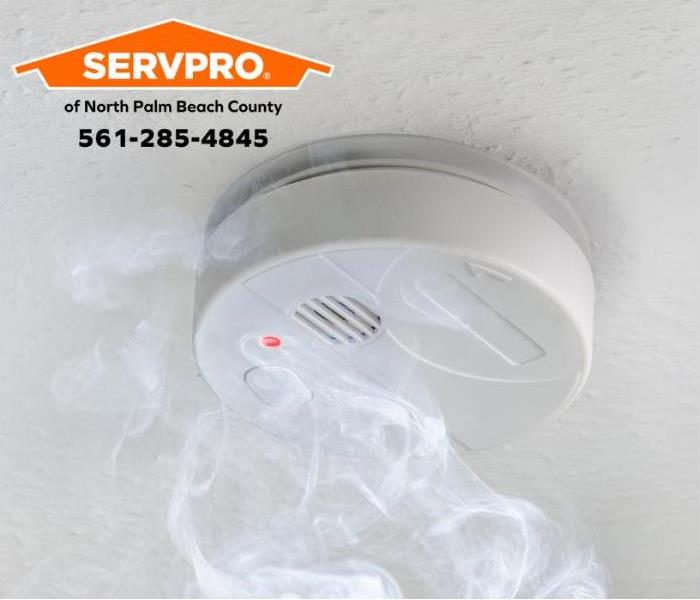 We respond to fire damage emergencies 24-hours a day.
We respond to fire damage emergencies 24-hours a day.
Smoke alarms are a key part of a home fire escape plan. When there is a fire, smoke spreads fast. Working smoke alarms give you early warning so you can get outside quickly. Here are some helpful tips from the National Fire Protection Association (NFPA) about smoke alarms:
SAFETY TIPS
- Install smoke alarms in every bedroom. They should also be outside each sleeping area and on every level of the home. Install alarms in the basement.
- Large homes may need extra smoke alarms.
- It is best to use interconnected smoke alarms. When one smoke alarm sounds, they all sound.
- Test all smoke alarms at least once a month. Press the test button to be sure the alarm is working.
- Current alarms on the market employ different types of technology including multi-sensing, which could include smoke and carbon monoxide combined.
- A smoke alarm should be on the ceiling or high on a wall. Keep smoke alarms away from the kitchen to reduce false alarms. They should be at least 10 feet (3 meters) from the stove.
- Replace all smoke alarms when they are 10 years old.
Call Us Today!
When your home or commercial business needs fire restoration services, SERVPRO of North Palm Beach County has a team of highly trained technicians on-call and ready to respond 24-hours a day.
Fire Damage in North Palm Beach County, Call SERVPRO
2/22/2024 (Permalink)
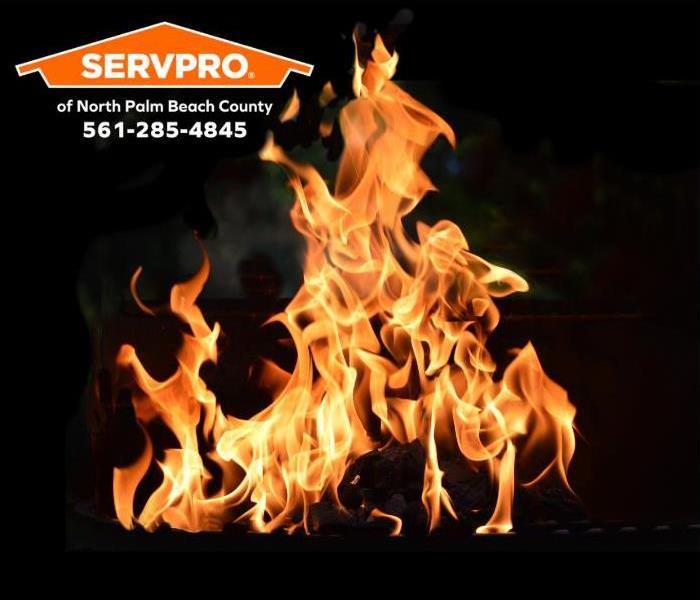 We respond to fire damage emergencies 24-hours a day.
We respond to fire damage emergencies 24-hours a day.
Even small fires will cause smoke and soot damage to other areas of the house. The professionals at SERVPRO of North Palm Beach County are trained and certified to clean and restore fire damage quickly and efficiently. Here are some tips from our website on things you can do while waiting for help to arrive:What To Do After A Fire• Limit movement in the home to prevent soot particles from being embedded into upholstery and carpets.• Keep hands clean so as not to further soil upholstery, walls, and woodwork• Place clean towels or old linens on rugs, upholstery, and carpet traffic areas• If electricity is off, empty freezer and refrigerator and prop doors open• Clean and protect chrome with a light coating of petroleum jelly or oil• Wash houseplants on both sides of leaves• Change HVAC filter• Tape double layers of cheesecloth over air registersWhat NOT To Do After A Fire• Don't attempt to wash any walls or painted surfaces or shampoo carpet or upholstery without contacting us• Don't attempt to clean any electrical appliances that may have been close to fire, heat, or water without consulting an authorized repair service• Don't use any canned or packaged food or beverages that may have been stored near the fire, heat, or water• Don't turn on ceiling fixtures if the ceiling is wet. The wiring may be damaged.• Don't send garments to an ordinary dry cleaner. Improper cleaning may set smoke odor.Call Us Today!When your home or commercial business has fire, smoke, and soot damage, SERVPRO of North Palm Beach County is available to help. Call us today at 561-285-4845.
Safety Tips for Patio Heaters
7/26/2023 (Permalink)
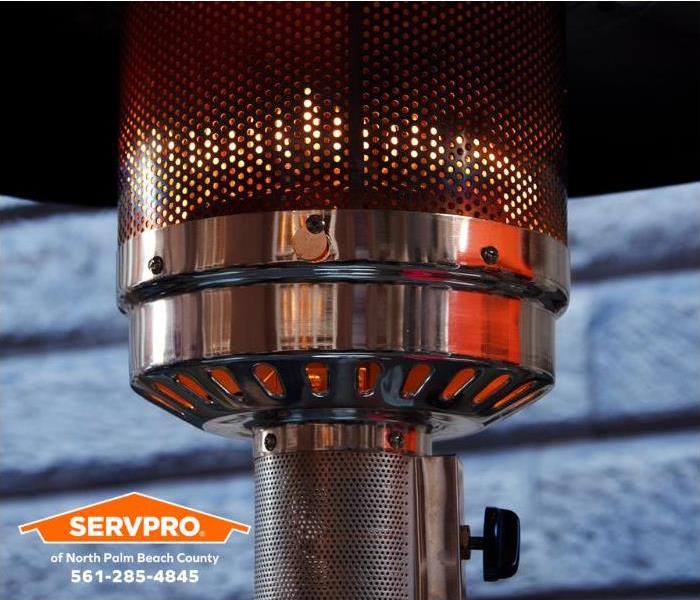 We respond to fire damage emergencies 24-hours a day.
We respond to fire damage emergencies 24-hours a day.
SERVPRO of North Palm Beach County responds to commercial fire damage emergencies throughout the year. More businesses are using propane heaters to keep customers and employees warm on chilly days and nights. Here is some information from the National Fire Protection Association for using outdoor propane heaters safely:
Propane Patio Heaters
For patio heaters that use integral LP-Gas containers with a capacity greater than 1.08 lb. (0.49 kg), NFPA 1 requires that the heaters be listed by an organization acceptable to the authority having jurisdiction (AHJ).
Propane heaters need to be used in accordance with their listing and manufacturer instructions. Prior to using a propane heater, refer to the manufacturer’s instructions for information such as the following:
- Necessary clearances from the heating element
- Proper ventilation required
- Proper inspection, cleaning, and maintenance procedures
- Lighting and shutdown procedures
- Where the heater can and cannot be used (for example, heaters cannot be used in enclosed locations)
- Procedures for properly storing heaters
The restrictions for using propane heaters are also based on the occupancy in which they are used. For example, in assembly occupancies, such as restaurants with 50 or more occupants, heaters cannot be located within 5 ft (1.5 m) of the exits. Regardless of where they are used, if a heater uses propane hoses, they must be as short as possible, visible, and protected from damage.
Call Us Today!
When your North Palm Beach home or commercial business needs fire damage restoration services, SERVPRO of North Palm Beach County is Here to Help. ® Call us today at 561-285-4845.
Protecting Your Pets from a Home Fire
9/21/2022 (Permalink)
 Make sure your family is aware of the pet fire safety plan.
Make sure your family is aware of the pet fire safety plan.
When it comes to house fire prevention, most people have a plan. But does your home fire safety plan include your pet? Pets are a part of the family. We care for them as we would a child. The most important thing to do to protect your pets, is to evacuate with them. However, it is important to never delay escape or endanger yourself or family to rescue a pet.
Before Fire
- Install smoke detectors and fire alarms. Ensure your home is equipped with fire extinguishers.
- Prevent your pet from starting a home fire. According to the National Fire Protection Association, almost 1,000 home fires per year are accidentally started by a pet. You can minimize your chance of a pet-started home fire by: extinguishing open flames before leaving the house; protect stove knobs with covers; secure young pets in a crate or within a safe boundary like a baby gate.
- Keep collars on and leashes handy. Always leave collars on pets. Keep leashes handy should emergency personnel need to rescue your beloved pet. If your pet is crated, keep the crate near an entrance to your home.
- Attach a pet alert window sticker to your front window. These handy window clings are available at most pet stores. The sticker or cling allows you to include critical information such as the number of pets within the home.
- Note where your pet likes to hide. In an emergency situation, knowing your pet’s location will save time and ensure a safe escape for all.
- Have the number and address of your animal hospital handy.
- Practice your escape plan with your pet. Include your pet in fire and safety drills. Train your pet to come when you call them. Ensure they are comfortable in a crate so you can grab them and go.
- Take a pet first aid training. The American Red Cross offers a cat and dog first aid course online.
During Fire
- In the event of emergency evacuation, take pets within you when possible. However, if you or your family are in immediate danger, you should not delay escape to rescue a pet.
- Immediately inform responders if your pet is still inside. If it is unsafe to evacuate with your pet, first responders will look for your pet.
- Bring leash and carrier. If there is no time to secure your pet prior to escape, you should attach a leash or put them in a carrier once safely outside.
- Never go inside a burning house. If you cannot find your pet, leave the door open and call them from a safe distance.
After Fire
- Check your pet for injury and smoke inhalation. Once you are safe from a home fire, it’s time to assess your pet. If your pet is having trouble breathing, ask rescue personnel about pet oxygen masks. If you have taken a pet first aid class, you will be better equipped to handle this situation.
- Have your pet examined by a veterinarian or emergency animal hospital. Smoke inhalation can cause injuries and death to your pet.
- Find a loving home to temporarily house your pet if you are no longer able to. Ask your veterinarian for recommended boarding facilities, or find a family member to care for your pets.
Make sure your family is aware of the pet fire safety plan. Run fire drills and regularly check fire safety equipment. Knowing the plan will safe valuable time in case of an emergency.
Avoiding Kitchen Fires in Your Home
6/1/2022 (Permalink)
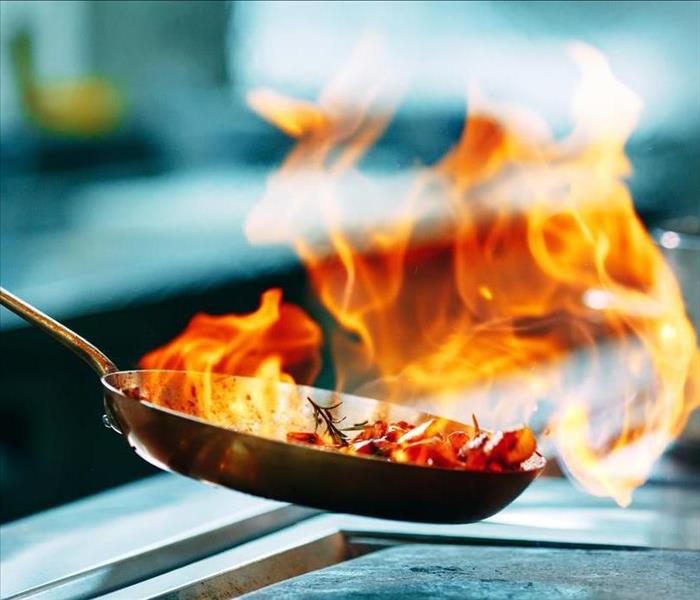 Cooking is the leading cause of home fires, accounting for an estimated half of reported home fires.
Cooking is the leading cause of home fires, accounting for an estimated half of reported home fires.
People often refer to the kitchen as the heart of the home. It’s the place where families congregate and satiate. Think about how much time your family spends in the kitchen. Since the kitchen plays a vital role in our lives, it is imperative to make it a safe space. Your kitchen may pose a great risk to your family. In fact, cooking is the leading cause of home fires, accounting for an estimated half of reported home fires.
According to the National Fire Protection Association (NFPA), United States fire departments responded to approximately 172,900 home fires per year in the previous few years resulting from cooking. These fires caused more than $1 billion in direct property fire damage per year.
The following steps will help you to be proactive in protecting your home and family from kitchen fires.
Never Leave Cooking Unattended
The NFPA lists unattended cooking as the leading cause of cooking fires and deaths. The best advice is to only cook when you actually have time to cook. Never put something on the stove while tending to other activities. Moreover, you should never leave the home while your oven is on. When cooking on the stove or in the oven, always set a timer.
Install and Test Smoke Alarms
While smoke alarms do not prevent home kitchen fires, they are an excellent precaution. Your smoke alarms should double as carbon monoxide (CO) detectors. One type of alarm will not substitute for the other. It is essential to have both or a combination alarm. Make sure smoke alarms are UL rated, well-maintained, and properly installed. New smoke alarms have a sealed 10-year battery that is non-replaceable and non-removable. If you are using a smoke alarm with removable batteries, change them twice per year. Install alarms on every level of your home, including basements, and where you sleep. Test alarms and clean regularly by dusting or vacuuming.
Fire Safety Equipment
In addition to smoke alarms and carbon monoxide detectors, equip your kitchen with a fire extinguisher. Read the directions and check on a monthly basis to ensure you are prepared to use it in an emergency. Ensure you are knowledgeable about when and how to use a fire extinguisher. It is important to note that most kitchen fires should NOT be doused with water. The majority of home kitchen fires initiate from grease or electrical appliances. Water will make a grease or electrical fire worse. The best way to put out a kitchen fire, other than when an extinguisher is used, is to cover the fire with either a lid or baking sheet, or by pouring a box of baking soda on top.
Keep Flammable Items Away from the Heat
Clear your workspace prior to starting each time you cook. Dishtowels, oven mitts, paper products, etc. should never be near your heat source. Loose-fitting clothing poses a similar risk; roll up sleeves and tuck in flowy articles of clothing prior to the start of cooking. A flammable object can cause a home kitchen fire even if it is not making direct contact with the flame. Always keep your cooking areas clean and free of clutter.
Cooking Temperatures
Be mindful of cooking temperatures, particularly when using oil for frying foods. Stay cognizant of the flashpoint, when the oil is hot enough to ignite on its own.
Escape Plan
Think about your fire escape plan. In an emergency, thoughts can be unclear and panicky. Your escape route should be well thought out and practiced. Consider all scenarios to best prepare your family.
When in doubt, evacuate your home, close all doors on your way out, and call 911. Fire departments are best equipped to deal with an emergency fire situation. It is important to act quickly to minimize fire damage. Above all, most home kitchen fires are preventable. Keep the heart of your home and your precious family safe by proactive preparation.
Family-Friendly Fire Escape Plans
4/7/2022 (Permalink)
 The adults in the home must establish a home fire escape plan and share that plan with all members of the household.
The adults in the home must establish a home fire escape plan and share that plan with all members of the household.
A home fire is one of those disasters that everyone thinks is impossible to happen to them. Like in the movies, a home fire is seemingly a random occurrence that is unlikely to happen in real life. However, home fires occur far more often than many South Florida homeowners imagine. As such, being prepared is paramount to keeping your family safe from the potential harms of a home fire. The first step in home fire safety is creating a fire escape plan.
When an accidental fire occurs in a home, a family will depend on three critical elements: 1) smoke detectors and fire alarms, 2) a fire escape plan, and 3) rapid response from the local fire rescue department. With this in mind, homeowners should be in the routine of regularly checking that their smoke alarms are working properly. Check the batteries once a quarter to ensure that you will be alerted to smoke/fire in your home. In addition, the adults in the home must establish a home fire escape plan and share that plan with all members of the household.
Your home first escape plan should include:
- First, establish all possible exits and ensure that all family members understand where they are and how to access them. This should be determined by looking at the layout of the home and deciding the quickest way to get out depending on where the person may be in the home.
- Exit strategy should include dropping to the ground and staying low as you crawl to the primary fire exits.
- Establish secondary fire exits, like windows, in the event that it is not safe to leave through the primary exits.
- Discuss a meeting location that is far enough away from the house that everyone can reside there while fire rescue professionals address the fire.
- Practice, practice, practice. It is not enough to create a fire escape plan, family members must rehearse this plan to ensure that everyone is prepared in a high-stress situation.
Young children will need assistance throughout the process of escaping a fire, but knowing a general plan will help everyone in the home to react as safely and as efficiently as possible. As always, if you or a loved one have suffered from a home fire, our fire damage and restoration team is ready to help. Contact SERVPRO of North Palm Beach County today to learn more.
Avoiding Kitchen Fires in Your Home
2/8/2022 (Permalink)
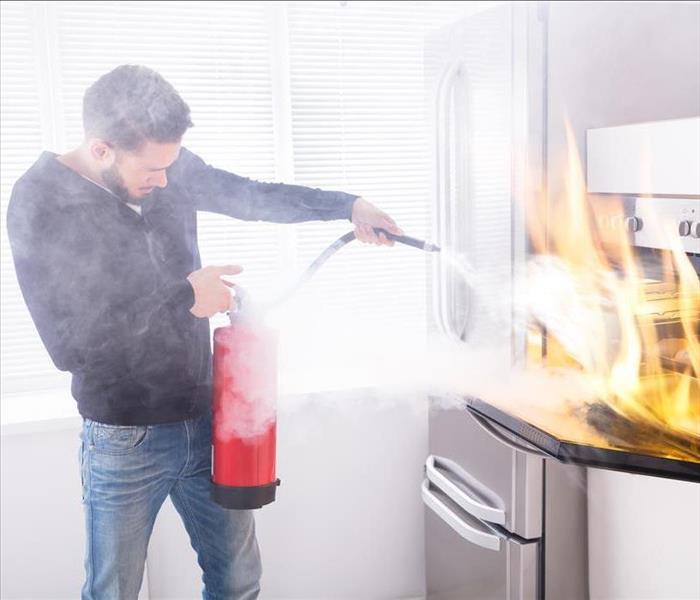 Recognizing the most common causes of home fires in the kitchen is a critical step to practicing fire safety.
Recognizing the most common causes of home fires in the kitchen is a critical step to practicing fire safety.
The kitchen is often the central location in a home. A place to congregate, a place to eat, and a place to enjoy family and friends, the kitchen is one of the most lively parts of any house. Unfortunately, the kitchen is also the most common place for a home fire to start. Cooking presents a lot of potential hazards, most notably being the possibility of a fire. In fact, about half of all home fires begin in the kitchen, nearly all of which are sparked by a cooking incident. With 350,000 home fires occurring each year in the U.S., the National Fire Protection Association (NFPA) estimates about $7.2 billion of property damage directly linked to home fires.
While no one anticipates a kitchen fire happening in their own home, taking extra precautions is imperative to keeping your loved ones safe. Understanding the most common causes of home fires in the kitchen is the best way to proactively avoid them from occurring in the first place. Keep the following tips in mind to avoid kitchen fires in your home:
- Never leave food unattended on the stove top
- Inspect your appliances every 10 years and ensure there are no issues
- Repair any broken appliances right away
- Avoid cooking at extremely high temperatures, even when in a rush
- Make sure that no flammable objects are being stored in the kitchen
- Limit frying oil to just cover the bottom of the pan, as oil can spread flames extremely fast
- Exercise extra caution on holidays like Thanksgiving, Christmas, and Easter when more cooking takes place
Recognizing the most common causes of home fires in the kitchen is a critical step to practicing fire safety. Implementing the above safety tips will prove to be instrumental in keeping your loved ones safe from fires in the kitchen.
Smoke Alarms and Your Home
12/14/2021 (Permalink)
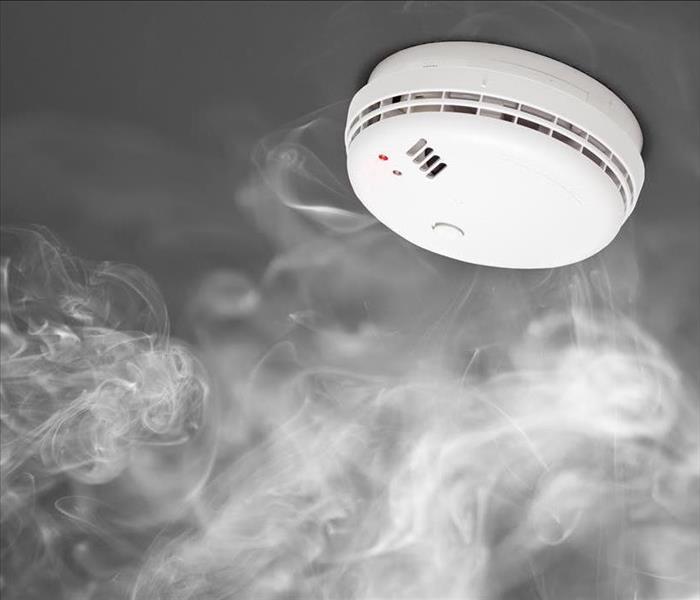 With proper care and maintenance, a fully functioning smoke alarm can be the difference between life or death when escaping a fire in your home.
With proper care and maintenance, a fully functioning smoke alarm can be the difference between life or death when escaping a fire in your home.
When it comes to protecting your family and loved ones in a fire, it is absolutely essential to prepare ahead of time. According to the U.S. Fire Administration, three out of five home fire deaths result from fires in properties without working smoke alarm. Fortunately, the risk of dying is cut in half when a home has a working smoke alarm. These alarms are usually the first line of defense when it comes to alerting your family about the fire with enough time to escape safely.
Here are answers to some of the most commonly asked questions when it comes to smoke alarms and your home.
How many smoke alarms should I have?
According to the National Fire Protection Association (NFPA), smoke alarms should be installed on every level of your home, including the basement. In addition to this, smoke alarms should also be installed inside of every bedroom and outside of each sleeping area.
Other recommended areas for smoke detectors include: all hallways, each living area (kitchen, family room, dining room, den, home office, etc.), stairwells, and storage rooms.
Where should I place the smoke alarms in my house?
Smoke detectors need to be properly installed to be effective. Because smoke rises, the alarms need to be placed high on the wall or close to the ceiling. The basic guidelines for smoke detector placement include:
- Place wall-mounted alarms less than 12 inches from the ceiling.
- Mount basement smoke alarms on the ceiling at the foot of the stairs leading up to the main level.
- Keep your smoke alarm at least 10 feet from your cooking appliances in the kitchen to minimize false alarms from smoke while cooking.
- Avoid placing smoke alarms next to windows, doors, vents, fans or anywhere where a breeze could affect the alarm.
How often do I need to replace my smoke alarms?
The best rule of thumb is to test your smoke alarm once a month. The batteries to your smoke alarm should be replaced every six months. An easy way to remember this is to change the batteries in your smoke detector the same day you switch your clock for daylight savings, once in the spring and once in the fall. Finally, according to the U.S. Fire Administration, smoke alarms should be completely replaced every 10 years.
With proper care and maintenance, a fully functioning smoke alarm can be the difference between life or death when escaping a fire in your home.
As always, SERVPRO of North Palm Beach County is here for you in the event of a fire. Our fire damage restoration team has years of experience in restoring properties to their pre-fire condition. Call our office today to learn more.
Fire Safety in an Apartment Building
10/25/2021 (Permalink)
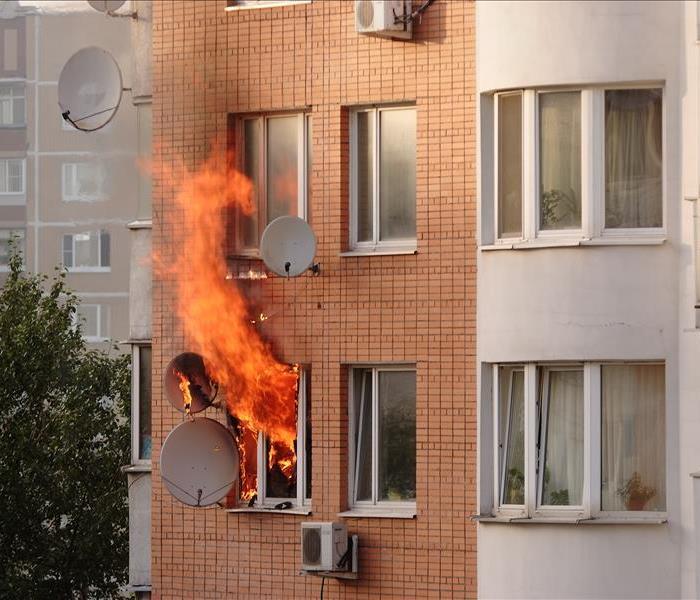 Like home fires, most of these causes are just everyday activities that can lead to fatal mishaps.
Like home fires, most of these causes are just everyday activities that can lead to fatal mishaps.
While the thought of a fire is scary no matter where you live, in a shared living space, such as an apartment or dorm, the fear may be even stronger. With many residents living in close quarters, with long hallways and corridors, and many different escape routes, fire safety in an apartment building is unique from other situations but needs to be prioritized.
What are the biggest causes of apartment fires?
Unsurprisingly, the most common origin of apartment fires is the same as fires in the home. According to the U.S. Fire Administration, more than half of apartment fires are started from cooking related incidents. Other causes cited included heating mishaps, electrical equipment malfunctions, candles, and smoking inside. Like home fires, most of these causes are just everyday activities that can lead to fatal mishaps.
What are the best ways to practice fire safety in an apartment?
Stay smart
While it may seem like common knowledge, you should always be extra careful with any cooking or heating in your apartment. You should never leave an open flame unattended, whether that be a candle or a stove top. Make sure these flames are not close to any combustible items, such as curtains, towels, or any other fabrics. Also, it is safest to avoid smoking in your apartment altogether.
Check for reliable fire protection
One of the easiest things that apartment residents can do to practice fire safety is to ensure that they have a working smoke detector. Every room in your apartment should have one. To test your smoke detector, push the test button at least once a month. If there is any problem with your smoke detector, you should inform your landlord and have it fixed immediately.
Not every apartment building comes with a fire extinguisher, but you can always keep one on hand to stay prepared. A small investment like this one could very well save yourself in a fire.
Know your escape plan
In case of an emergency, you should know all the possible exits to safety get from your unit to outside. A good exercise for apartment dwellers is to count the number of doors between your apartment and the closest fire exit. If you are on a higher floor, it is a good idea to invest in an escape ladder just in case the lower floors are unsafe.
Additionally, in a fire, you should not prop open any exits or doors. These often are in place to prevent the spread of any flames. Be on the lookout for any fire risks in hallways and common areas and notify your building management if anything feels unsafe.
Just like in a home fire, after you escape, you should never re-enter the building under any circumstances.
Keeping Your Pets Safe in a Fire
9/7/2021 (Permalink)
 Hoping for the best and planning for the worst is an important mindset to have when it comes to home fire preparedness.
Hoping for the best and planning for the worst is an important mindset to have when it comes to home fire preparedness.
A home fire is something that most homeowners think will never happen to them. But when the unthinkable happens it is critical to have a plan in place. While many families have an escape plan in place in case of a fire emergency, few think about what will happen with their pets in the event of a fire. Protecting your pet in an emergency is something that everyone wants to do in theory, but with a plan things can go disastrously wrong. According to the American Kennel Club, approximately 40,000 pets die in home fires each year. This means that planning for pet safety in a fire is extremely important.
Hoping for the best and planning for the worst is an important mindset to have when it comes to home fire preparedness. First and foremost, all adults must ensure that the human loved ones in their family are out safely. Never sacrifice the safety of a human in an attempt to save a pet. However, the goal is to be able to get the entire family out safely, including furry family members. The following are some important tips to keep in mind for pet fire safety:
- Keep a collar on your pet at all times for easier evacuation
- When leaving the home, keep your pets in a room or area that could be easily accessed by a firefighter
- Young pets should be kept away from possible fire hazards like candles or electrical wires
- Ensure that all fire alarms are working
- Keep a list of the number of pets inside the home on your front door
It is important to note that pets can start fires. Be sure that stove knobs are covered and that your pets are never near an open flame unattended. A home fire is terrifying and acting quickly is paramount. As such, having a fire safety plan in place that includes your pets is your best protection against a tragedy. As always, be sure to reach out to SERVPRO of North Palm Beach County for all of your fire damage repair and fire damage restoration needs.
Keeping Children Safe in a Home Fire
7/13/2021 (Permalink)
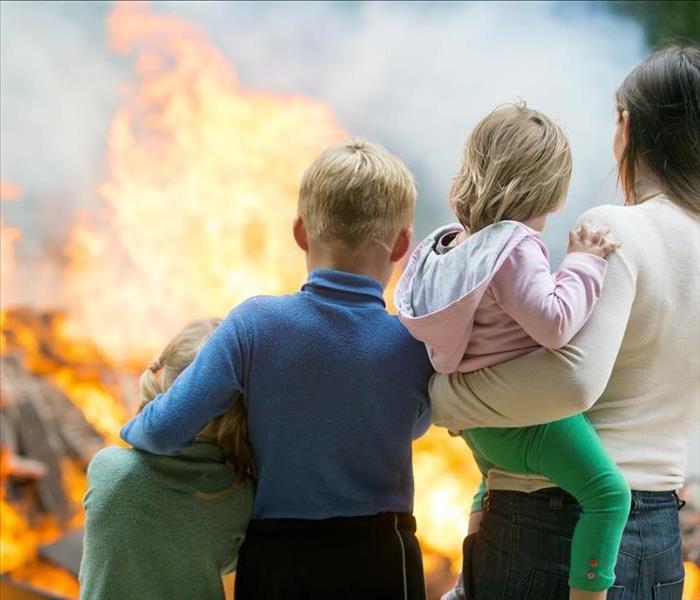 While no one likes to think about the worst case scenario of a home fire, doing so it imperative to protecting your little ones.
While no one likes to think about the worst case scenario of a home fire, doing so it imperative to protecting your little ones.
One of the leading causes of death for kids under the age of 15 are burns and fires. Home fires are extremely scary and dangerous, so prevention is essential to keeping children safe. The mindset that it will “never happen to me” is the foundation of home fire danger, as it leads to minimal or no planning and preparation. While it is most important for parents to have a fire safety plan in place, it is also extremely important for children to be prepared as well. Fire safety efforts can truly be the difference between life and death in the event of a home fire.
The U.S. Fire Administration (USFA) recently reported a 4 percent increase in home fires over the last decade. A tiny flame can escalate into a life-threatening fire in only two minutes and with home fires on the rise, homeowners must be vigilant in prevention and preparation. The following recommendations are vital to keeping your children safe in a home fire:
- Regularly speak with your children about fire hazards and home fire safety
- Teach your children about firefighters by taking them to the local fire department – this will ensure that they are not afraid of a firefighter in the event of a fire
- Make sure all lighters and matches are out of reach
- Institute a fire escape plan and practice every 6 months
- Make sure that all smoke alarms in the home are properly functioning
- Practice the STOP-DROP-and-ROLL method
- Keep children away from things like candles and stoves
- Teach children how to dial 9-1-1 in case a parent is unavailable to do so
- Reiterate the importance of evacuation and staying out of the home
While no one likes to think about the worst case scenario of a home fire, doing so it imperative to protecting your little ones. Far too many families who have suffered in a home fire could have prevented injuries with a little practice and preparation.
At SERVPRO of North Palm Beach County, we have over 34 years of experience in fire damage repair and restoration. If you or a loved one have suffered damage in a home fire, contact our fire damage experts today for immediate help.
Top Causes of Kitchen Fires at Home
5/24/2021 (Permalink)
 Even though accidents do happen, by knowing the most common causes of kitchen fires, you can learn the best ways to prevent them.
Even though accidents do happen, by knowing the most common causes of kitchen fires, you can learn the best ways to prevent them.
The majority of fires that occur in the home start in the kitchen. According to the National Fire Protection Association (NFPA), there are more than 350,000 home fires each year in the U.S., leading to more than 2,500 deaths and $7.2 billion in direct property damage. In addition to this, cooking presents the highest risk for a home fire, with around 50% of home fires starting in the kitchen. Tragically, major holidays such as Thanksgiving, Christmas Day, Easter, and Christmas Eve are some of the peak days for home fires, when more cooking than usual takes place in the home. Even though accidents do happen, by knowing the most common causes of kitchen fires, you can learn the best ways to prevent them.
Here are the top causes of kitchen fires in the home:
Kitchen Appliances
While all kitchen appliances can all present themselves as fire hazards, the most common place for a fire to start in the home is on a stove top. When cooking on the stove top, always be sure to stay alert and do not leave any food unattended.
Additionally, it is important keep your kitchen appliances well-maintained. A faulty appliance can possibly result in overheating or create sparks, which could be the start of an electrical fire. As a general rule, after 10 years of use your appliances should be inspected to check for any potential hazards.
Extreme Cooking Temperatures
Attempting to cook your food at a temperate higher than recommended can lead to your food in flames. Even if you’re running short on time, do not attempt to set the oven temperate higher to cook food faster. If your food sets ablaze, this can have deadly consequences.
Flammable Objects in the Kitchen
Objects that can catch and spread present a major fire hazard in the kitchen. When cooking, you should ensure that there are no curtains, towel racks, hand towels, wooden utensils, fabric oven mitts and pot holders, or even paper towel dispensers too close to any burners that could ignite and spread any flames.
Frying Oil
If you are cooking with oil, be sure to take extra safety precautions as oil can spread fires at an extreme rate. When using oil in a pan, only use enough to cover the bottom of the pan and, if you are deep-frying, try to use a controlled deep-fryer rather than oil in a pot.
How To Make a Fire Escape Plan for Your Family
4/12/2021 (Permalink)
 While all buildings need to have a fire escape plan, the most important place to prepare for is your home.
While all buildings need to have a fire escape plan, the most important place to prepare for is your home.
Being prepared in case of a fire is one of the best things you can do to keep your family safe. Smoke detectors, fire alarms and escape plans are all crucial steps to prepare for an accidental fire in your home. While all buildings need to have a fire escape plan, the most important place to prepare for is your home, especially if you’re living with young children. Everyone should be on the same page in terms of your escape route.
Reacting to the Fire
In an intense situation like a fire, it is important to act quickly and follow certain protocol. The first step in any fire escape plan is deciding how to react when a smoke alarm goes off or a fire is spotted. Within only minutes, a small flame can become a widespread fire so it is important that everyone knows how to keep themselves safe.
When exiting the building, it is important to drop to the floor to avoid the smoke that is rising. When moving around, keep low and crawl to the primary fire exit and try to keep your face covered with any clothing or piece of cloth. If any handle is hot, it is not safe to enter the room. Even though the official safety recommendation is to exit the building on your own as soon as possible, every parent is going to save their child, so it is important to factor that into your escape plan. Once you are outside, do not reenter the building under any circumstance.
Mapping Your Escape
After setting the expectations during an emergency, it is important to map out the route you and your loved ones can take. Print out a full layout of your home and make a note where everyone sleeps and where all possible exits are. With this information, you can draw out the primary exits, which are the quickest options, everyone can take and the secondary exists if those are blocked. Make sure that everyone is aware of every the exists, including windows.
Meeting Up
It is very important to choose one spot that everyone will safely meet up with when outside. If everyone is in the same place. This will make it easy to see if everyone has made outside and prevent anyone from unnecessarily running back into the building. A good choice for this location is a tree sear the side of the road at the end of the driveway with an unobstructed view of the house. Make sure every child and adult is aware of where this meeting point is located. As soon as you reach this meeting point, call 911 for help.
Rehearsing Your Fire Escape Plan
In order to be best prepared in case of an emergency, it is important to rehearse your family’s fire escape plan. After first hearing the smoke detector, everyone’s should be focused on safely heading to the meeting place. You should check your smoke detector batteries every month, and this is a great time to go over your fire safety plan. Especially for children, reiteration is very important. Making a fire plan is easy and in case of an emergency, can save lives.
What You Need to Know About Smoke Alarms
2/15/2021 (Permalink)
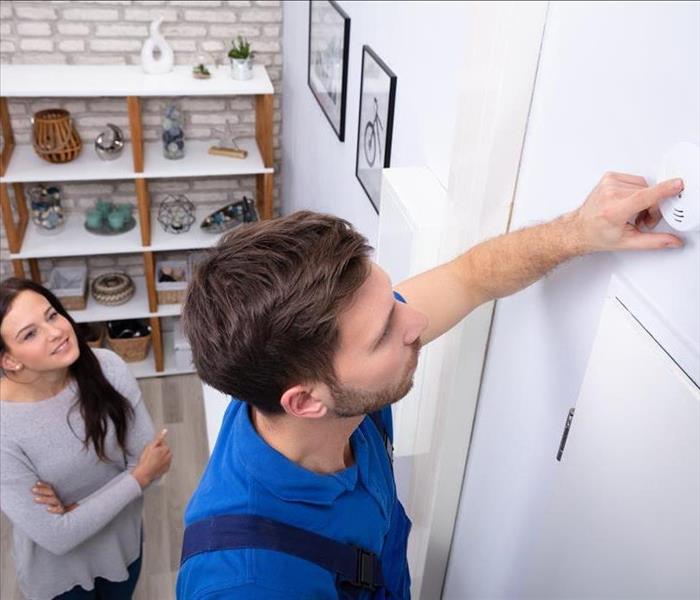 Many people have no idea when they last replaced their smoke alarms or even whether or not they were installed properly.
Many people have no idea when they last replaced their smoke alarms or even whether or not they were installed properly.
Home fires are something that every person tries to avoid. While many people think that it is something that would never happen to them, the truth is that home fires occur much more often than people realize. Prevention is of course the most ideal aspect of home fire safety. Smoke alarms are a home’s most loyal ally when it comes to fire safety prevention efforts. According to research, the people inside of a home have less than 2 minutes to evacuate the household safely once the smoke alarm sounds off. This means that a specific fire safety plan is absolutely critical for every single family.
There are a few major points that a homeowner must realize when it comes to fire safety and smoke alarms. Some tips may seem obvious, but it would surprise you to know that many homeowners are completely unaware of some of the most basic smoke alarm safety tips. Keep the following things in mind to ensure your family and home are prepared:
- Replace the smoke alarms throughout the home every 10 years
- Test your smoke alarms once a month
- Replace your smoke alarm batteries once a year (with a 9-volt battery)
- Create a fire safety plan with your family and go over it once a year
- Once the smoke alarm sounds, everyone should know to exit immediately
- Smoke alarms are interconnected, so when one goes off all of them should start to ring
- Hesitation upon hearing the smoke alarm is often the key cause of injury and death in a home fire
Many people have no idea when they last replaced their smoke alarms or even whether or not they were installed properly. From replacing batteries to consistently checking functionality, it is imperative to be proactive when it comes to your home’s smoke alarms. At SERVPRO of North Palm Beach County, we are fire damage experts. Contact us today to learn more.
Cooking Safety Tips for the Holidays
12/21/2020 (Permalink)
 This year, keep the following cooking safety tips in mind to avoid fire damage.
This year, keep the following cooking safety tips in mind to avoid fire damage.
The holiday season is a time when everyone is in the kitchen. Gathering around the table to enjoy a special feast that you and your family prepared is truly priceless. Warm plates and warm hearts are truly what the holidays are all about. Even if you are only able to celebrate with a small group of family members this year, taking some time to stop and appreciate all that you have is so important. At SERVPRO of North Palm Beach County, we cherish the holiday season and the connection that we have built with our community.
While the holidays and meals go hand-in-hand, thinking through holiday cooking safety tips is something that many people overlook. Unfortunately, cooking accidents happens all too often this time of year. This year, keep the following cooking safety tips in mind to avoid fire damage:
- Never leave the stove on if the kitchen is unattended
- Keep a fire extinguisher somewhere near the kitchen area
- If frying, boiling, grilling, or boiling food, stay in the kitchen
- Make sure that the stovetop is clear of things like oven mitts, towels, food packaging, and wooden utensils
- Hot grease should be disposed of in a garbage can
- Use timers as much as you possibly can
- When simmering, baking, or roasting foods be sure to check on them regularly
- If an oven fire occurs, turn off of the heat and leave the door closed
- If a small fire occurs on the stove top, smother the flames with a lid and turn off the burner
- If you have any doubt about your ability to stop a small fire in your kitchen, immediately exit your home and call 911
From turkeys to ham and from casseroles to delicious desserts, everyone is sure to indulge this holiday season. Keep fire safety tips in mind while you cook with your family this week. And remember, if you have suffered from any fire damage we are here to help!
5 Unexpected Home Fire Starters
11/4/2020 (Permalink)
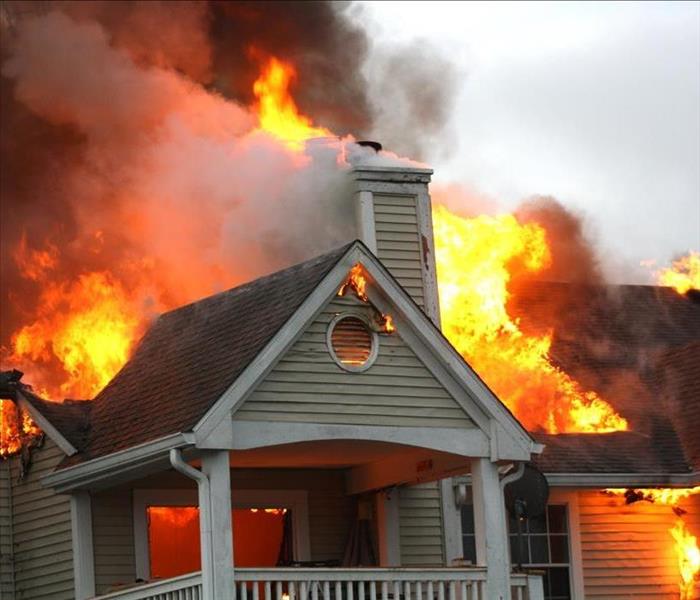 There are a number of surprising causes that people do not think of as fire hazards.
There are a number of surprising causes that people do not think of as fire hazards.
Home fires are an extremely frightening to think about and something that many homeowners assume will never happen to them. While a home fire may seem like a rarity, there are approximately 4,000 deaths each year due to home fires in the United States. The National Fire Protection Association states that a new home fire is reported in the United States every minute and a half. So, while it may seem like an infrequent occurrence, home fires are in fact prevalent and dangerous across the country.
Fire damage is quick to occur and often impacts large areas of a home. As such, working to prevent a home fire from happening in the first place is critical for all homeowners. First and foremost, every family should have a fire emergency plan. From escape routes to checking on family members to grabbing particular must-have possessions, this plan should be thorough, understood, and reviewed regularly by the entire family. Next, it is important to determine some of the most common causes of home fires.
When people think of home fires then often associated them with dryers, candles, and smoking. However, there are a number of surprising causes that people do not think of as fire hazards. The following are some of the most unexpected home fire starters:
- Circuit Breakers: Old or faulty wiring in a circuit breaker can catch fire more easily than many think.
- Dishwashers: The heating and motor components in a dishwasher can cause a fire, even though there is plenty of water present.
- Jars: when the sun reflects off of a glass jar a fire can start, as such is it is critical to avoid keeping flammable liquids in a glass jar.
- Smoke Detectors: what surprises many, smoke detectors themselves can catch on fire due to a malfunction.
- Old Appliances: wiring in outdated appliances has a tendency to become faulty and can thus present a fire hazard.
The above causes of home fires makes it clear that it is up to the homeowner to not only act responsibly in keeping hazardous materials in check, but they also must make sure to regularly check appliances throughout the home for functionality. At SERVPRO of North Palm Beach County, we are fire damage experts. Contact us today to learn more!
Smoke Damage After a Home Fire
9/8/2020 (Permalink)
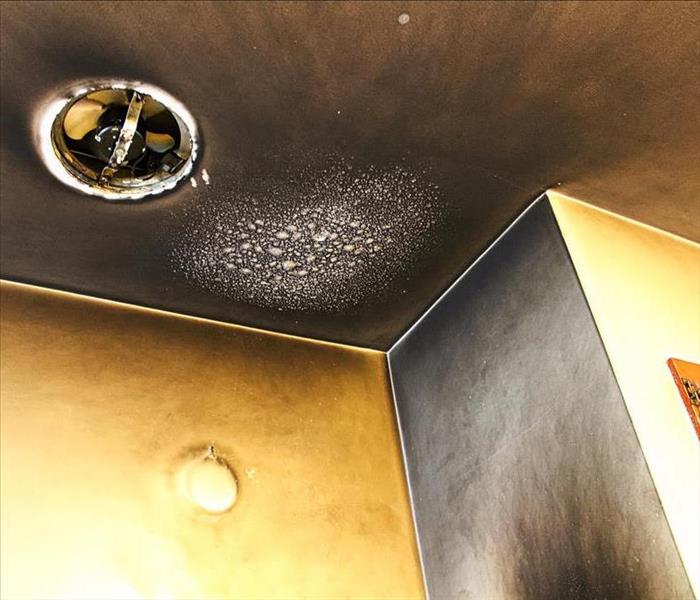 Properly recovering after a home fire requires a fire restoration technician, an odor control technician, & upholstery and fabric cleaning technician.
Properly recovering after a home fire requires a fire restoration technician, an odor control technician, & upholstery and fabric cleaning technician.
Thinking about a potential fire in your home is something that no one wants to do. While we are lucky that in Florida we face much better conditions than California, where wildfires are a massive problem, we still need to consider the possibility of a home fire. From issues with electrical equipment to mistakes made during the holiday season, Florida home fires do happen. When it comes to home fires and the damage that they bring to a property, most people focus their attention on the actual flames and the direct damage caused by them.
While the flames of a fire are certainly harmful and damaging, smoke damage is another factor that must be taken into account. From charring to discoloration, smoke damage can leave a home looking really rough after a fire breaks out. Some of the most notable issues include:
- Discoloration
- Charring
- Yellow stained walls
- Yellow stained ceilings
- Warped wood
- Warped plastic
- Toxic air inside of the home
- Soot in household textiles
- Smoke odor in carpets, upholstered furniture, clothing, and drapery
- General smoke odor throughout the home
Dealing with smoke damage goes far beyond restoring the look of the home, smoke damage repair must attacks odors and toxins. In most cases, properly recovering after a home fire will require a fire restoration technician, an odor control technician, and an upholstery and fabric cleaning technician.
At SERVPRO of North Palm Beach County, we specialize in fire damage and smoke damage repair and restoration. We understand that each and every home fire is different and thus requires a unique solution that is customized for the specific conditions at hand. If you or a loved one has suffered from a home fire and smoke damage, we are here to help. Call our team today to learn more about your options!
14 Top Causes of House Fires
7/2/2020 (Permalink)
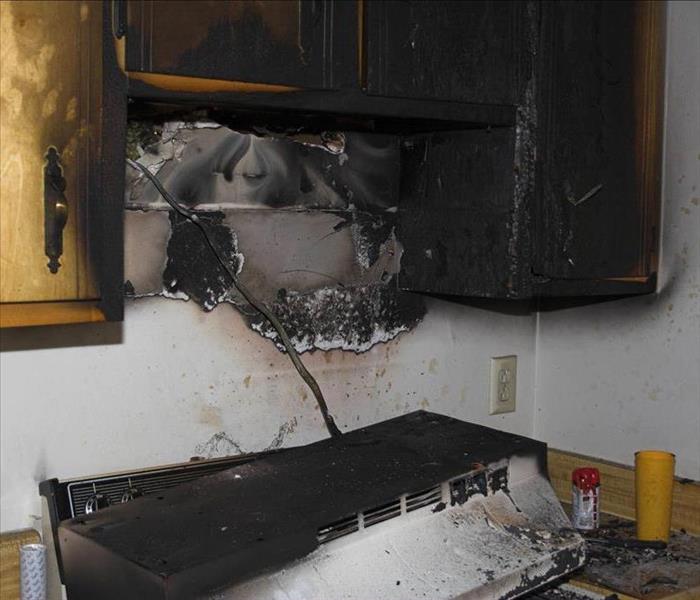 With so many uncertainties surrounding home fires, the best defense is a good offense.
With so many uncertainties surrounding home fires, the best defense is a good offense.
House fires are often looked at as one of those “it would never happen to me” tragedies. The truth is that home fires happening constantly throughout the country. In fact, research from the National Fire Protection Association points out that a home fire occurs every 86 seconds in the United States. Recognizing that the potential for a fire to start in your home is the first step in taking preventative and proactive measures to protect yourself, your family, and your home.
The nature of a home fire lends itself to unpredictability. With so many uncertainties surrounding home fires, the best defense is a good offense. That means learning and understanding the most common causes of home fires in order to take measures to prevent them from occurring in your own home. The following are the top causes of house fires today:
- Candles
- Electrical equipment
- Cooking
- Barbeques
- Inadequate wiring
- Smoking
- Lighting equipment
- Dryers and washing machines
- Flammable liquids
- Heating equipment
- Christmas decorations
- Lightning
- Curious children
- Arson (intentional fires)
As you can see from the above list, nearly every single cause of home fires is an avoidable action. For instance, being on top of equipment maintenance in your home, keeping dangerous items away from children, and exercising extra caution while cooking can prevent a fire from starting in the first place.
Of course, there are always accidents and unavoidable circumstances that may lead to a house fire. If your home as suffered fire damage, we are here to help. At SERVPRO of North Palm Beach County, our fire damage restoration experts are ready to help you any time, any day!
9 Tips to Prevent a Home Fire
5/5/2020 (Permalink)
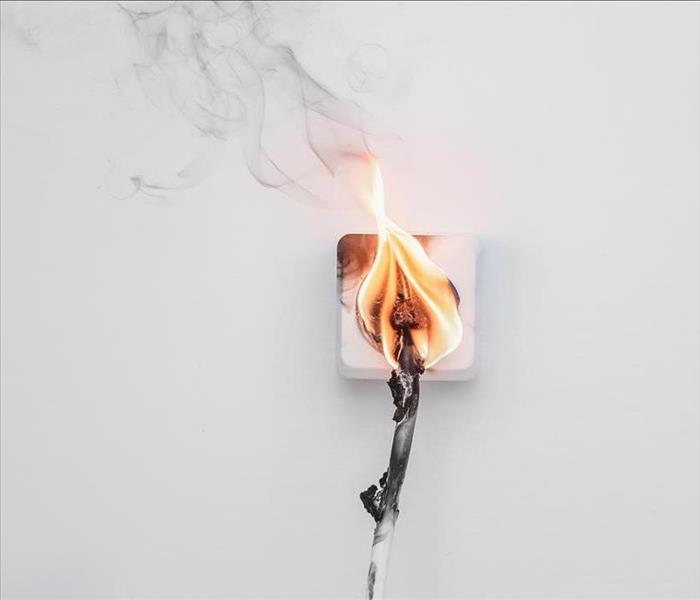 Preventing a home fire means taking proactive measures to ensure that your home and your family are as safe as possible.
Preventing a home fire means taking proactive measures to ensure that your home and your family are as safe as possible.
Estimates show that about 2,500 deaths occur each year due to home fires throughout the United States. While that may seem like a small number compared to other disasters, the reality is that almost all home fires are preventable. South Florida homeowners know that house fires do not happen every day. When something occurs so infrequently, it can be easy to forget about the possibility of it happening in the first place. This type of thinking is what lays the foundation for a potential fire.
With this in mind, we found that it is particularly important to think about the possibility of a home fire. In doing so, you are preparing your mind and significantly increasing your chances of avoiding one from happening. Keep the following tips in mind to prevent a home fire:
- Test your smoke alarms every month
- Change batteries in your smoke alarm as needed, do not delay
- Keep your oven and stove clean
- Keep an eye on the functioning of kitchen appliances and the dryer
- Make sure that your mattress has flame-retardant chemicals inside
- Check chords around your house and make sure there are no frayed ends
- Be extra cautious with candles, never leave the house with an open flame
- Store all flammable products properly
- Keep fire extinguishers easily accessible and check for functionality
Preventing a home fire means taking proactive measures to ensure that your home and your family are as safe as possible. While everyone fears the worst, the above tips will prove to be instrumental in avoiding a fire from starting in your house. However, if the unthinkable happens we are here for you. SERVPRO of North Palm Beach County has decades of experience in home fire damage restoration. Call us today to learn more!
9 Most Common Kitchen Fire Hazards
2/27/2020 (Permalink)
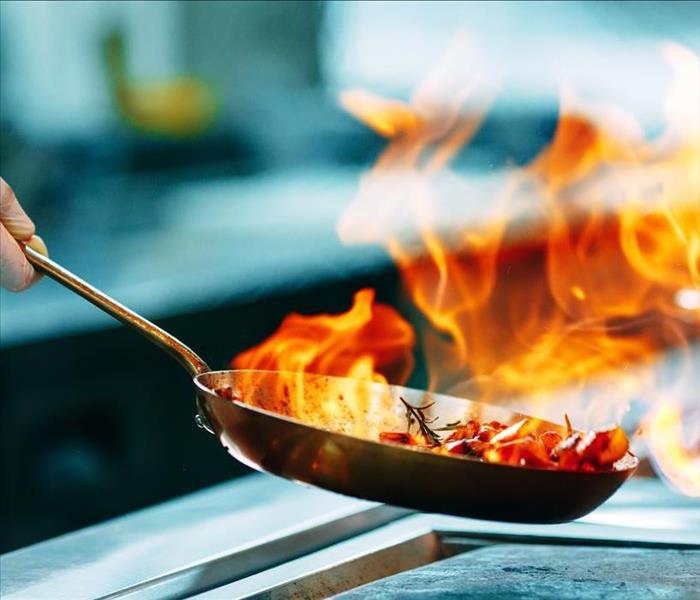 Knowing the most common risks associated with cooking in the kitchen can help to eliminate some of the risk.
Knowing the most common risks associated with cooking in the kitchen can help to eliminate some of the risk.
Home fires are scary. What can start out as a simple flames can transform into a full-blown fire in only 30 seconds. Most homeowners fail to think about the potential for a fire in their house. They falsely assume that something like that would never happen to them, especially in South Florida. However, if the California fires have taught us anything, it is that home fires can happen in an instant.
Unsurprisingly, the kitchen is the biggest culprit for fires. From inside of your home to your favorite local restaurant, kitchen fires are extremely common and can result in serious injury. As such, it is important to be aware of the most typical causes of kitchen fires to use extra precaution to avoid them from occurring in the first place.
The following are some of the most common kitchen fire hazards to look out for:
- Grease fires from oil spills on the stove top or grill
- Microwave firs from microwaving things like metal
- Keep flammable items near an open flame
- Walking away from the kitchen while frying food on the stove top
- Cooking at a temperature that is too high
- Keep a kitchen hand towel too close to an oven or stove top
- Appliance malfunction
- Loose clothes catching fire
- Too many people in the kitchen
Knowing the most common risks associated with cooking in the kitchen can help to eliminate some of the risk. However, it is crucial to recognize that safety measures must be taken at all times while using the kitchen. Even the simplest of tasks, such as microwaving, can become hazardous if the right precautions are not taken.
At SERVPRO of North Palm Beach County, we have decades of experience in fire damage restoration. If you or a loved one has suffered fire damage to your home or commercial property, call our fire damage experts today for immediate help.
What Happens In a Home Fire?
12/28/2019 (Permalink)
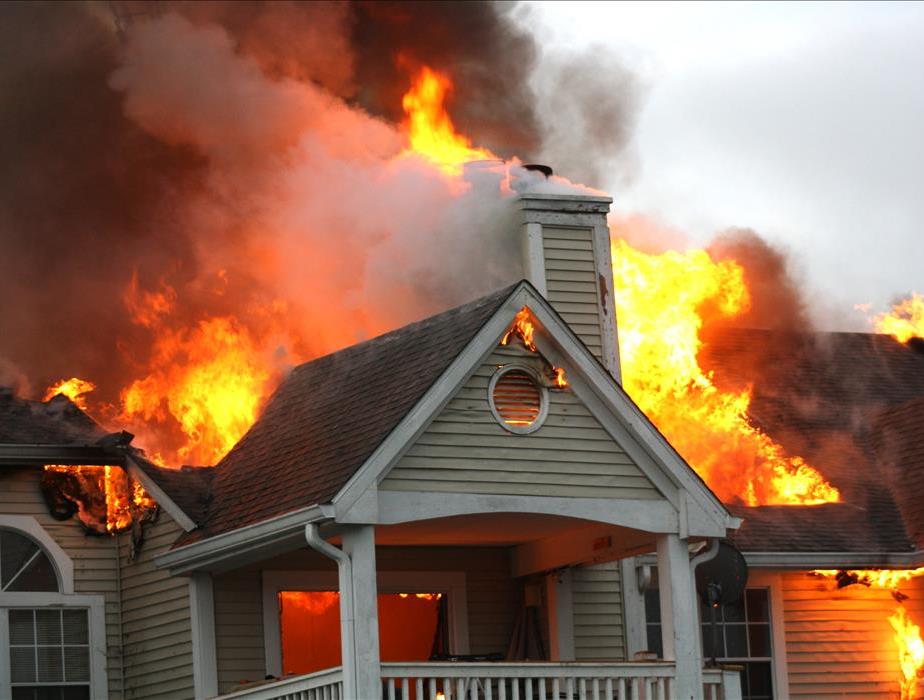 It’s easy to think that a fire would never happen in your home, but it can truly happen to anyone.
It’s easy to think that a fire would never happen in your home, but it can truly happen to anyone.
In a blink of an eye a small fire can transform into a full blown house fire. In fact, a small flame has the propensity to become a major fire in as little as 30 seconds. We see it fictionally in countless movies and television shows and we watch the real stories about it on the news. But how does it all happen? What takes place when that small flame emerges as a terrifying fire wreaking havoc on your home?
For starters, it is important to discuss the difference between home fires today versus home fires a few decades ago. In older times, experts estimated that you had anywhere from 14 to 17 minutes to escape in the event of a house fire. Today, however, the level of flammability in the household limits escape time down to 2 to 3 minutes. That means that home occupants have the get out extremely fast before the entire house goes up in flames.
Let’s take an example scenario into account. Fires most often begin in the kitchen. A stovetop meal starts to boil over and before anyone knows it, oil is igniting and spreading flames throughout the kitchen. Then, cooking utensils catch fire, which then catch onto the dish towel, and fire and smoke are looming. More and more flammable items begin to burn and the flames spread rapidly to the wooden cabinets to the curtains, and on and on.
While this scenario may be horrifying to think about, the reality is that this happens all of the time throughout the United States. It’s easy to think that something like this would never happen in your home, but it can truly happen to anyone. Being extremely careful in the kitchen and when dealing with any fire, even something as simple as lighting candles, is imperative to keeping you and your loved ones safe. Have you experienced any type of fire damage? Our fire damage restoration team is here to help. Contact SERVPRO of North Palm Beach County today to learn more!
Practicing Safety With Holiday Decorations This Year
11/8/2019 (Permalink)
 Far too many people underestimate the level of danger associated with holiday decorations and they leave themselves, and their families, at risk.
Far too many people underestimate the level of danger associated with holiday decorations and they leave themselves, and their families, at risk.
Holiday season is right around the corner and that means many families throughout South Florida will be decorating their homes. Whether it’s stockings on a mantle or lights on the roof, being careful during this time of year is crucial. Hanging lights is not only a time-consuming and tedious task, it is also potentially very dangerous. As such, it is important for South Florida homeowners to be extra cautious this year while decorating their houses.
According to the Consumer Product Safety Commission (CPSC), holiday decorations caused over 15,000 injuries that lead to an emergency room visit. From falls to fires, understanding how to properly put up your Christmas lights is essential to staying safe and having a happy holiday. The following tips are helpful to practicing safety with holiday decorations this year:
- Purchase Christmas lights that have a UL Safety Certification
- Choose clips to hang the lights, as opposed to screws or nails
- Make sure you are using outdoor lights outdoors and indoor lights indoors
- Discard any damaged or old Christmas lights
- Turn off the lights when you go to sleep at night
- Consider changing to LED lights
- Always use a GFCI outlet
- Be extra careful when using a ladder and do so with a partner
- Christmas lights should never be run through doors or windows, use outside outlets only
- Do not plug in more than three light sets into one extension cord
Electrical and fire hazards are abundant during the holiday season. While it may take a few extra steps and purchases to maintain proper safety levels, it is extremely important to take every precaution possible. Far too many people underestimate the level of danger associated with holiday decorations and they leave themselves, and their families, at risk of serious injury.
If you or a loved one has suffered from fire damage in your home, SERVPRO of North Palm Beach County is here for you. Contact us today for more information!
Understanding the Most Common Causes of Florida Home Fires
9/18/2019 (Permalink)
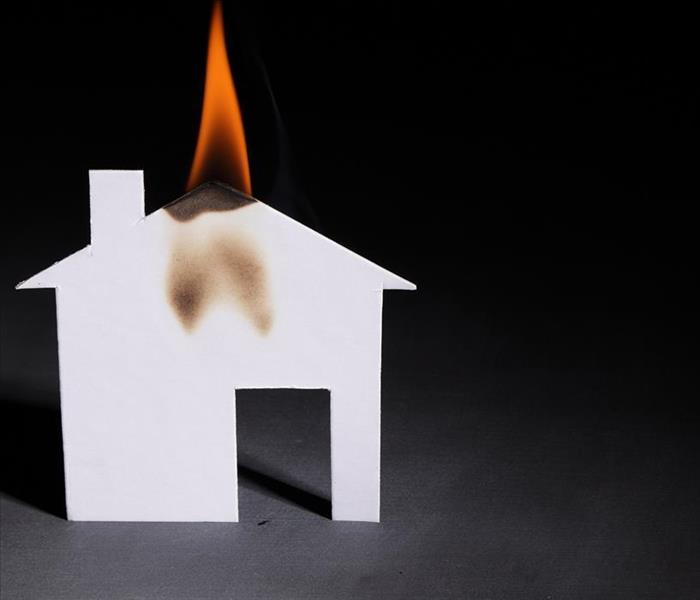 Far too many people underestimate the likelihood of a fire starting in their house.
Far too many people underestimate the likelihood of a fire starting in their house.
People usually think about states like California when it comes to fires, but Florida homeowners must be aware of the potential dangers linked to fires as well. In fact, Florida is actually ranked in the top 10 for states with the most fatal home fires across the country in 2018. These numbers are based on fatal house fires per capita and highlight the importance of being prepared for anything.
The National Fire Protection Association (NFPA) estimates that anywhere from 250,000 to 275,000 home fires occur each year. While fires are unpredictable by nature, the reality is that house fires often start from only a handful of common causes. Being aware of these potential hazards is the first step in preventing them from occurring. The following are the most common causes of Florida home fires:
- Smoking
- Cooking
- Electrical Issues
- Candles
- Heating Equipment
In addition to these typical causes, home appliances can also be a concern. Pay close attention when using items like the dryer, oven, and toaster. Taking every precaution when doing the above activities is imperative to keeping your home a safe environment. Far too many people underestimate the likelihood of a fire starting in their house. As a result, they are caught off guard when the unexpected occurs and are ill-prepared to handle the fallout.
At SERPVRO of North Palm Beach County, we pride ourselves on our ability to act quickly. When the unthinkable happens, you can trust that our fire damage repair team will work diligently to cleanup and then restore your home to pre-fire condition. Contact us today to learn more about our fire damage restoration services!
Fire Escape Planning for You and Your Family
7/25/2019 (Permalink)
 These quick and easy steps will help your family to feel prepared in an emergency fire situation.
These quick and easy steps will help your family to feel prepared in an emergency fire situation.
No one expects a fire to start. It’s one of those “it will never happen to me” emergencies, and so many people neglect thinking about or planning what they would do if the unthinkable occurs. Home fires take place all over the country, for all different reasons. In fact, every 88 seconds U.S. fire departments respond to a home fire. With such a high frequency of fires in homes across the nation, it is imperative that everyone has a plan.
Creating a fire escape plan for you and your family, and going over that plan regularly, can truly be the difference between life and death. First and foremost, call a family meeting to establish a plan that is agreed upon by everyone. Walk through your home to inspect the most logical escape routes. Then, discuss with your children where they should go and with whom they should go with in the event of a fire.
Once a plan is established, go to each exit and ensure that the windows and/or doors open easily. Additionally, make note of where the smoke alarms are located throughout your home. Finally, select a location a safe distance from your house where everyone should meet after escaping the house. These quick and easy steps will help your family to feel prepared in an emergency fire situation.
If you or a loved one has experienced fire damage or smoke damage in your home, SERVPRO of North Palm Beach County is here to help. Contact our fire damage experts today to learn more!
Facts About Home Fires
6/16/2019 (Permalink)
Homeowners often think about the many safety hazards associated with owning and maintaining a home, yet the threat of a fire is seldom mentioned. Contrary to popular belief, home fires are rather common and something that everyone should be aware of. According to the national Fire Protection Associated (NFPA), an average of seven people die each day in the United States due to home fires.
Home fires are extremely prevalent throughout the country. In fact, U.S. fire departments estimate that they respond to a home fire every 88 seconds. That’s a lot of home fires. Being aware of some home fire facts will help to highlight the true nature of their potential danger:
- Cooking is the leading cause of home fires as well as home fire injuries
- More than half of all home fires occur because the smoke alarms are faulty or missing altogether
- More males are injured and die due to home fires than females
- Cooking equipment is the leading cause of home fires
- Each day, close to 30 home fires reported are caused by candles
Being a smart homeowner means being educated on all of the potential threats that exist. While it is impossible to prepare for everything, being aware of some home fire facts will place you in a better position to act safely on a daily basis and respond correctly in the event of an emergency. At SERVPRO of North Palm Beach County, we specialize in fire damage restoration. If you or a loved one has been involved in a fire and wish to return your property to pre-fire condition, give us a call today.
Fire Safety Plan for Children
5/3/2019 (Permalink)
 The more you practice as a family, the smoother your escape plan will be in the event of an actual emergency
The more you practice as a family, the smoother your escape plan will be in the event of an actual emergency
Do you have an emergency escape plan in place in the event of a home fire? Are you children aware of the plan and their role in getting out safely? Far too many parents neglect to make a fire escape plan altogether, no less making a plan and then communicating said plan with their children. The possibility of a fire seems so rare that most adults never even consider it as a possibility. While smoke alarms are useful, you are asking for trouble if they are the only active part of your fire escape plan.
Your children have likely engaged in countless fire drills in school. They are used to practicing in the event of an emergency and the home should be no different. A family fire drill should be discussed amongst adults and then practiced amongst the entire family. The following is a great basis to build your specific plan upon:
- Make an escape plan based on your home’s particular layout, be sure to identify two ways out of each room in the house
- Have each family member practice escaping the rooms by crawling on the perimeter of the room towards an exit
- Practice this routine multiple times a year, switching which of the two exits that they children leave from
- Ensure that each parent knows which children they are to oversee in the event of a fire
Children 5 years and older need to be made aware of this plan. The more you practice as a family, the smoother your escape plan will be in the event of an actual emergency. At SERVPRO of North Palm Beach County, our fire damage restoration specialists are available 24 hours a day, seven days a week. Contact our team today to learn more!
Dangers of Smoke Inhalation
3/11/2019 (Permalink)
 If your home has suffered from fire damage, SERVPRO of North Palm Beach County can help. Our fire and smoke damage restoration team is here for you!
If your home has suffered from fire damage, SERVPRO of North Palm Beach County can help. Our fire and smoke damage restoration team is here for you!
Home fires are one of the most frightening things that a family can experience. As a homeowner in South Florida, it is important to think about the potential for a home fire and what you and your family would do in that emergency situation. Does your family have an evacuation plan? If not, it’s time to start thinking about a fire escape plan. Far too many people underestimate the dangers associated with home fires, especially small home fires.
If a small fire occurs in your home, you may be tempted to run back inside to grab important personal items. While this may seem harmless, the reality is that smoke inhalation is extremely dangerous. So, even if the fire is small and contained, running back into the area where smoke is present can be a major risk to your health. A gas and fine particle mixture is what makes up smoke, and these elements can be a big health threat.
Some people are more susceptible to health issues related to smoke inhalation and should be extra careful to avoid exposure. For instance, older adults, children, pregnant women, and anyone with preexisting heart or respiratory conditions are more likely to get sick. Some of the immediate effects of smoke inhalation include:
- Coughing
- Runny nose
- Issues breathing normally
- Rapid heartbeat
- Chest pain
- Stinging eyes
- Headaches
- Scratchy throat
- Fatigue
- Sinus issues
- Asthma attack
- Wheezing
If your home has suffered from fire damage of any size, SERVPRO of North Palm Beach County can help. Our fire and smoke damage restoration team will get to work quickly in restoring your home to its previous condition. From smoke to soot to fire, this type of damage should be addressed immediately to reduce property damage. Contact us today to learn more!
Home Electrical Fires Risks and Consequences
1/3/2019 (Permalink)
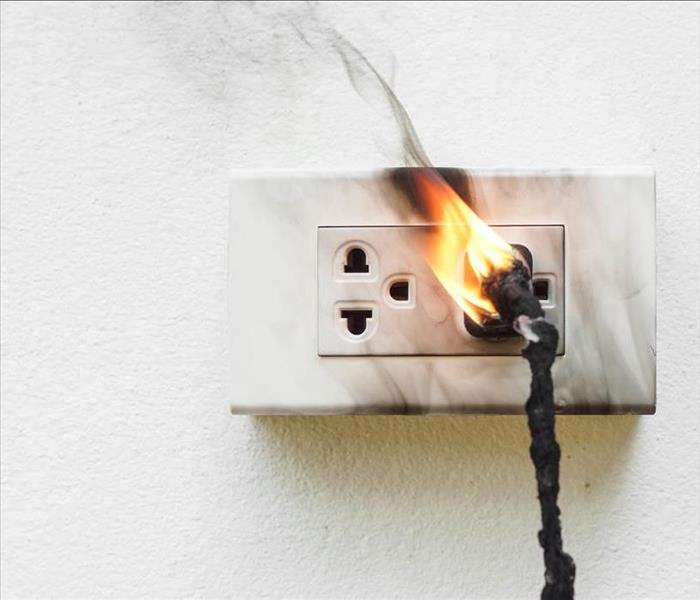 Being prepared and cautious is the best way to prevent home fires from starting.
Being prepared and cautious is the best way to prevent home fires from starting.
Home fires are all too common in the United States. While home fires can arise from a number of sources, residential building electrical fires are some of the most frequently seen issues throughout the country. As a South Florida homeowner, it is important to understand the risks and consequences associated with electrical fires in order to prevent them from starting in the first place.
The U.S. Fire Administration recently released a report outlining some of the most important statistics gathered from 2014 through 2016. The following facts and figures highlight the characteristics of home electrical fires from that time period:
- About 24,000 residential building electrical fires were reported
- Approximately 850 injuries and 310 deaths occurred as a result of the fires
- Property loss numbers reached about $871 million
- January saw the highest rate of electrical fires compared to any other months
- 15 percent of the residential building electrical fires started in bedrooms
While these numbers only scratch the surface, they serve to point out just how dangerous residential building electrical fires can be. Being prepared and cautious is the best way to prevent home fires from starting. If you or a loved one’s home has suffered from fire damage, contact SERVPRO of North Palm Beach County for immediate, reliable restoration services.
Fire Safety When Staying in Peer-to-Peer Lodging
11/10/2018 (Permalink)
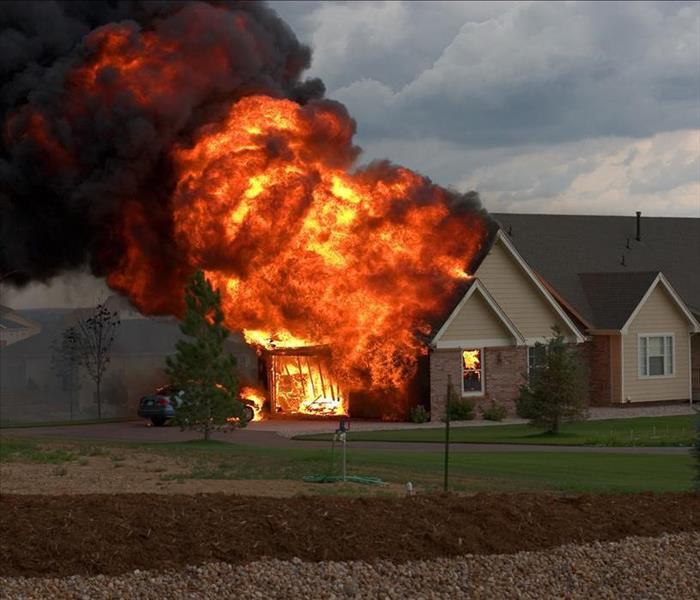 With this substantial growth in peer-to-peer lodging, there are a number of safety concerns that have arisen.
With this substantial growth in peer-to-peer lodging, there are a number of safety concerns that have arisen.
Peer-to-peer lodging companies have seen a massive growth over the last several years. With the lodging trends moving slightly away from hotels and resorts toward privately owned, short-term rentals like apartments and houses, corporations like Airbnb have seen impressive success and are only expanding their reach. In fact, this movement is said to be the fastest-growing substitute to hotels and motels.
With this substantial growth in peer-to-peer lodging, there are a number of safety concerns that have arisen. Today we focus on fire safety and how peer-to-peer lodging options have addressed the issue. While hotels and motels have a number of fire safety regulations, the same may not be able to be said for peer-to-peer lodging options. Code regulations as they relate to important items such as smoke alarms, fire doors, automated extinguishing systems, and posted fire escape routes are the norm in hotels and motels. However, peer-to-peer lodging does not see the same requirements.
Unfortunately, peer-to-peer lodging is mostly unregulated. Since the peer-to-peer lodging sector is so new, most code regulations have yet to reach them. While the private residences for peer-to-peer lodging properties likely fall under their local codes, there are still a lot of issues with a lack of uniformity in regulations. A study was performed by the U.S. Fire Administration and found that one in five Airbnb properties do not have a smoke alarm and about 50 percent do not list a CO alarm.
As such, it is important to keep fire safety in mind whenever staying at peer-to-peer lodging. Hopefully, regulations will soon catch up to that of hotel requirements.
Fire Safety Tips While Cooking
9/4/2018 (Permalink)
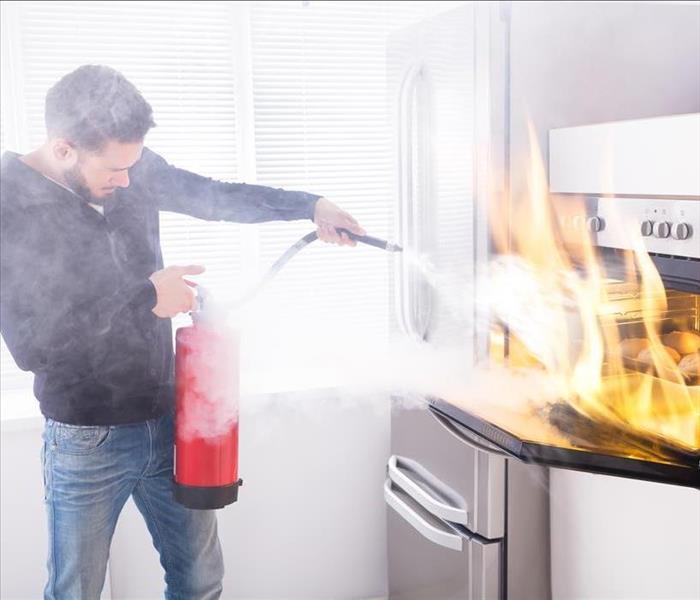 As you cook your meals this year, be sure to share these fire safety tips with your entire family.
As you cook your meals this year, be sure to share these fire safety tips with your entire family.
Cooking is a special activity that many families like to do together. Unfortunately, cooking fires are the leading cause house fires and home fire injuries today. According to the National Fire Protection Association (NFPA), 40 percent of all home fires begin in the kitchen and U.S. fire departments record that they respond to an average of approximately 166,100 cooking-related fires annually. There are about 455 daily fires in the United States and with cooking fires being the top source, it is important to be aware of how to prevent kitchen fires from starting in the first place.
Cooking equipment can be very dangerous if not used properly and carefully. Thanksgiving is actually the leading day for home fires involving some type of cooking equipment. That number is 4 times the average number of home fires! Since the average American household cooks at least one hot meal each day, it is absolutely essential to be doing so safely. These are some of the most critical fire safety tips to follow while cooking:
- Never leave the kitchen while boiling, frying, broiling, or grilling food
- Turn off the stove every single time the kitchen is left unattended
- Do not use the stove or stovetop if you have consumed alcohol or are feeling sleepy
- Keep items like wooden utensils, oven mitts, towels, and food packaging away from the stovetop
- Regularly check on food items that are roasting, baking, or simmering
- Always use a timer to remind yourself that you are cooking food
- Be aware of your clothing like large-fitting shirts or loose sleeves
- Keep a fire extinguisher near the kitchen
- Never throw away hot grease in the garbage can
- If a small fire starts on the stovetop, smother the flames with a lid to cover the pan and then turn off the burner
- If an oven fire starts, turn off the heat and do not open the door
- If you have any doubts about stopping the small fire, get out of the home immediately and call 9-1-1
As the fall holiday season begins, many families will be enjoying their time together in the kitchen. As you cook your meals this year, be sure to share these fire safety tips with your entire family. If your kitchen does suffer from fire damage, contact SERVPRO right away to handle the cleanup and restoration. Contact us today for more information!
Getting Smart about Smoke Alarms
6/8/2018 (Permalink)
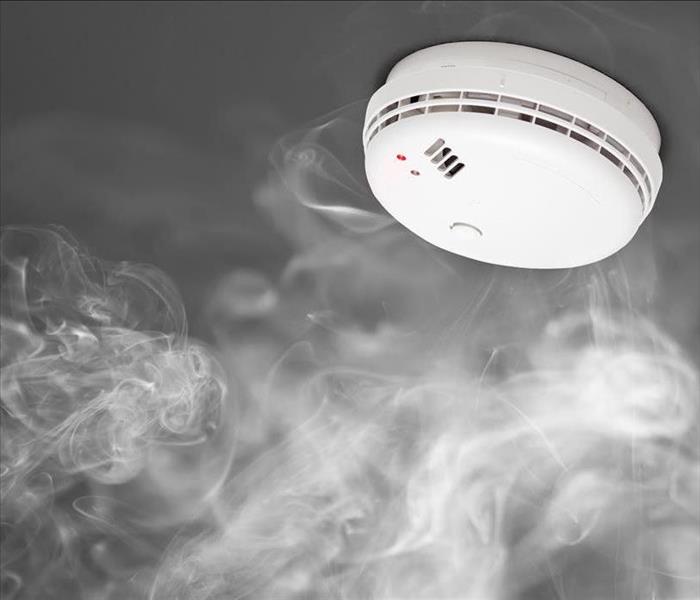 If you or a loved one has suffered from fire damage in your home, SERVPRO is here to help you recover from the tragedy.
If you or a loved one has suffered from fire damage in your home, SERVPRO is here to help you recover from the tragedy.
Fire safety is often associated with tips to prevent fires from starting and steps to take in the event that a home fire occurs. Research shows that when a smoke alarm sounds off in a household, the inhabitants have less than 2 minutes to get out of the house for safety. This means that families must have a very specific plan of action when it comes to fire safety. We have discussed this in previous articles, but we have never spent the time to talk about something extremely important: smoke alarms.
Did you know that smoke alarms need to be replaced every 10 years? Did you know that smoke alarm batteries (9-volt battery) need to be replaced at least once per year? Did you know that smoke alarms should be tested every month? These types of facts are things that are rarely discussed yet are extremely essential for each and every homeowner. Having a smoke alarm properly installed in your home can literally be the difference between life and death. Reports from the U.S. Fire Administration point out that three out of five home fire death result from fire in properties without working smoke alarms. This speaks to the massive dangers linked to malfunctioning smoke alarms and just how critical is it to be on top of your alarms at home.
There are a few additional tips beyond replacing smoke alarms every 10 years and batteries every year that each person should know. First, when discussing your evacuation with your family it is imperative to enforce that as soon as an alarm sounds off everyone should exit. Hesitation in exiting the home when a fire starts is a common issue. Also, smoke alarms in your home should be interconnected, meaning that when one alarm sounds off, they will all sound off. In doing so, everyone in the house will be made aware of the fire no matter their location.
Finally, smoke alarm placement is key. Be sure to have a smoke alarm inside and outside of any and all sleeping areas and bedrooms as well as installing alarms on every level of a home. If you or a loved one has suffered from fire damage in your home, SERVPRO is here to help you recover from the tragedy. Contact our team of fire damage cleanup professionals to learn more about your restoration options today!
Fire Safety Tips for Your Pets
4/30/2018 (Permalink)
 All homeowners with pets must think about their fire safety plans with their furry friends in mind.
All homeowners with pets must think about their fire safety plans with their furry friends in mind.
When it comes to evacuation and safety plans in the event of a fire, most homeowners plans for protecting their family and their most meaningful possessions like important documents and family photos. Home fires are far more common than many people think and having a specific plan in place is essential. For those family with pets, an additional level of fire safety must be accounted for in order to keep your furry family members safe and sound. Approximately 500,000 pets are affected by fires every year, according to research from the United States Fire Administration. Therefore, all pet owners are strongly encouraged to think about fire safety preparation for pets.
A family pet is truly like a real member of the family. As such, ensuring that your fire safety plan includes your pet is critical. Keep the following fire safety tips for your pets in mind:
- Never leave any open flames, like candles, unattended – especially if they are within the reach of your pet
- Watch out for things like space heaters getting knocked over by your animal
- Hide all electrical cords out of reach of your pets
- Do smoke detector checks twice a year
- Keep a collar on your pet
- Put a sticker on your windows and door to let firefighters know that a pet is inside the household
- Have a microchip implanted in your pet
- Account for your pet’s food when making emergency supply lists
- Keep your pet’s leash, food, and carrier by the home’s exit in case of a fire
According to the National Fire Protection Association (NFPA), about 700 home fires annually are started every year as a result of a pet or wild animal. All homeowners with pets must think about their fire safety plans with their furry friends in mind. If you have suffered any fire damage as a result of a home fire, contact the fire damage professionals at SERVPRO for immediate help!
Staying Safe in a House Fire
3/22/2018 (Permalink)
 SERVPRO has the specialized fire and water damage cleanup and restoration training and experience to quickly restore your home to pre-fire condition.
SERVPRO has the specialized fire and water damage cleanup and restoration training and experience to quickly restore your home to pre-fire condition.
A house fire is one of the most frightening things that a family can experience. The National Fire Protection Association estimates that there are more than 300,000 home structure fires each year in the United States, with an astonishing average of seven deaths per day linked to house fires. While the kitchen is the most common place that a fire starts inside of a home, areas like the living room, bedrooms, and family room are also sources of a sizable number of fires. As a homeowner in South Florida, it is absolutely essential for you and your family to be well-versed on an emergency plan in the event of a fire in your home.
A common misconception about house fires is that homeowners think “it will never happen to me”. Unfortunately, this mindset often leads to a lack of preparation that can make all of the difference in the event of an emergency. As such, keep these safety tips in mind for staying safe in a house fire:
- Do not rely on a fire alarm to inform all of the members of your family that a fire is present in the home, start yelling out loud
- Grab the fire extinguisher is the fire tame enough, but be sure to abort that plan and leave immediately if the fire extinguisher proves to be a futile effort
- Call 9-1-1 or the fire department
- Exit immediately and crawl low to avoid smoke inhalation
- Feel the doorknob before opening any door to ensure that it is not hot
- Leave your valuables in the home, get yourself and your family out as quickly as possible
- Use a damp towel or shirt to cover your nostrils so that smoke does not enter your lungs
- Never run into a room with flames present
- As you exit a room, close the door behind you to avoid the spreading of the fire
- Once you have evacuated the home, stay outside in a safe place and wait for first responders to arrive
House fires bring out a variety of instincts in people, and they are often dangerous responses to the emergency situation. Therefore, it is vital that you go over these safety tips with your family so that everyone is prepared in the event of a fire. After the fire trucks are gone, your and belongings likely suffer from not only fire and smoke damage, but also extensive water damage from firefighting efforts. SERVPRO has the specialized fire and water damage cleanup and restoration training and experience to quickly restore your home to pre-fire condition. Call us today to learn more!
6 Surprising Causes of Home Fires
1/5/2018 (Permalink)
 At SERVPRO, we always treat your family with the greatest empathy and respect, and we’ll treat your property with great care.
At SERVPRO, we always treat your family with the greatest empathy and respect, and we’ll treat your property with great care.
Home fires are incredibly scary to think about. In the most unsuspecting of times, homeowners must act quickly to protect their loved ones, their pets, and their most cherished home items. Unfortunately, in the United States nearly 4,000 people are killed each year from fires, that number is more than all natural disasters combined. In fact, approximately every minute and a half a new home fire is reported throughout the country, as reported National Fire Protection Association. While most people think of home fires as something that would never happen to them, the reality is that these occurrences strike far too many families across the nation. Fire damage is a serious problem, even for the smallest of home fires. As such, the ability to prevent a home fire from happening in the first place is absolutely critical.
Most people think that common fire starters like candles and cooking make up the majority of home fires. Nevertheless, it is important to be educated on all kinds of causes in order to prevent fires from starting in the first place. Some of the more surprising causes of home fires are as follows:
- Dishwashers: many people believe that since dishwashers have water in them they are incapable of causing a fire. However, the motor and heating elements in a dishwasher make it a potentially dangerous appliance.
- Jars: ant kind of glass object has the potential to catch fire from the reflection of the sun, so flammable liquids should not be stored in glass jars or glass containers of any kind.
- Outdated Appliances: old appliances have a tendency of having faulty wires and thus cause unexpected fires.
- Circuit Breakers: if the wiring in a circuit breaker is old or faulty it make catch fire.
- Smoke Detectors: even though smoke detectors are there to help in the event of a fire, they can actually catch fire on their own if they are malfunctioning. Make sure that your smoke detectors is not missing any batteries or malfunctioning in any way.
- Children Playing: when kids begin to experiment with things like lighters and matches, accidents tend to occur. Children should be kept far away from matches, lighters, and candles.
Fire damage can be devastating for you and your family. Feelings of confusion and stress are common, and you need a caring expert to guide you through this crisis. At SERVPRO, we always treat your family with the greatest empathy and respect, and we’ll treat your property with great care.
Basic Home Fire Escape Plan
10/5/2017 (Permalink)
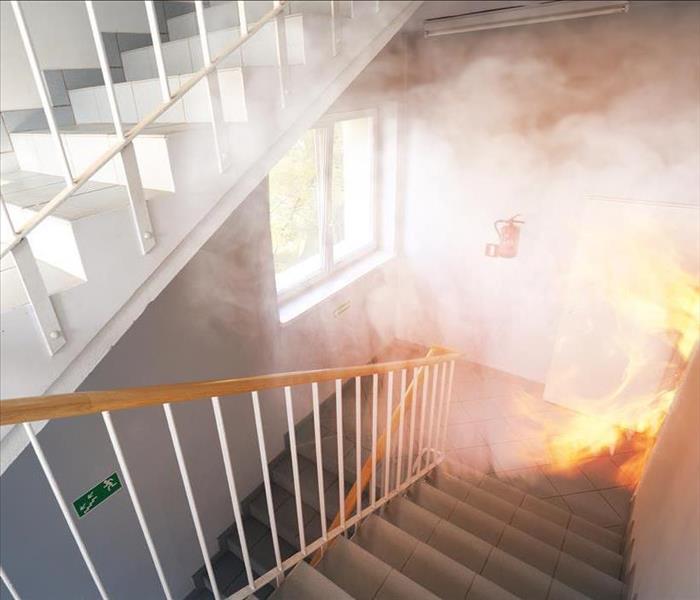 When it comes to fire safety, there is no better way to prepare than having a solid fire escape plan.
When it comes to fire safety, there is no better way to prepare than having a solid fire escape plan.
No one plans for a fire to break out inside of or near their home. Home electrical fires account for close to 500 deaths and over 1,400 injuries each year. In addition, home electrical fires cost billions of dollars in property damage annually. As such, preparing and planning an emergency escape strategy is critical to protecting you and your loved ones in the event of an unexpected home fire. First and foremost, your home should be inspected for working smoke alarms in every room. In addition, you must create a specific evacuation plan, practice fire drills, and make sure that your entire family is well-versed in what to do in the event of an emergency.
Keep in mind the following pieces of advice when developing and deploying your personal home fire escape plan:
- Keep all exits unblocked (both doors and windows throughout the house)
- Make an escape route for each individual room in the home
- Smoke alarms should be placed in every room, on every level of the home, and outside of any sleeping area
- Walk through your escape plan with entire family
- Choose a location a safe distance away from your home as your family’s meeting place
- Memorize the fire department’s emergency phone number, make sure your family does as well
- Assign a capable adult to be in charge of any infants, elderly people, or anyone that lacks mobility and would require assistance in an emergency
- Take every smoke alarm signal seriously and evacuate immediately
- Inform guests or visitors in your home of the fire escape plan
- Never go back into a burning building before being cleared from the firefighters on the scene
Creating a home fire escape plan is absolutely essential for everyone. Whether you live in a single-family home or a high-rise apartment building, be sure to prepare yourself for the steps that would be taken in the event of a fire. When it comes to fire safety, there is no better way to prepare than having a solid fire escape plan.
Dryer Fire Prevention Tips
7/18/2017 (Permalink)
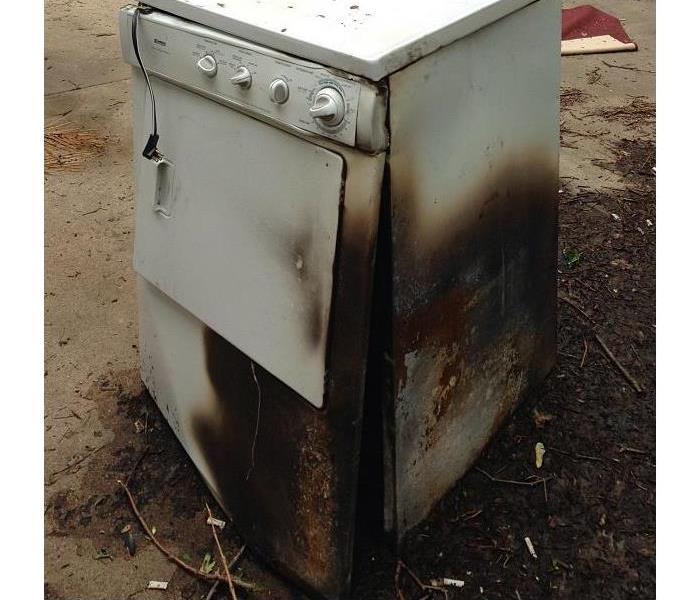 If you have experienced dryer fire in your home, SERVPRO is here to deal with the fire damage.
If you have experienced dryer fire in your home, SERVPRO is here to deal with the fire damage.
Each year in the United States homeowners suffer from the aftermath of clothes dryer fires. In fact, nearly 15,000 home clothes dryers catch fire each year which in turn cause about 100 injuries. While it may surprise some, neglecting to clean your dryer is the most common cause of a fire. As such, preventing dryer fires is actually easy if the homeowner is aware of the potential of fire damage and takes steps to avoid an accident from occurring in their home.
Keep in mind the following tips for dryer fire prevention:
- Hire a professional to install your dryer, do not attempt to do this yourself
- Make sure that your laundry room has no flammable items inside or near the dryer
- Clean your linen filter both before and after every single load of laundry
- Get your dryer serviced regularly
- Be sure that your dryer’s vent pipe is free, blockage is one the top causes of dryer fires
- Hire a professional to look at your gas lines
- Never run your dryer when you are asleep or not home
- Avoid overloading your dryer
- Clean your dryer in any place where lint can build up
- Use metal dryer ducts
- Check the electrical outlet and plug to ensure it is connected correctly
- Do not dry any items containing rubber, foam, or plastic
- Do not dry clothes that have anything flammable on them such as gas, alcohol, or cooking oils
- Leave ample room between your dryer and the wall behind it
- Read your manufacturers’ instructions to go over particular safety tips for your dryer
From lack of maintenance to dirty dryers, almost every single dryer fire each year is caused by something that could have been avoided. If you have experienced dryer fire in your home, SERVPRO is here to deal with the fire damage. Call us today to learn more!
Most Common Causes of House Fires
6/30/2017 (Permalink)
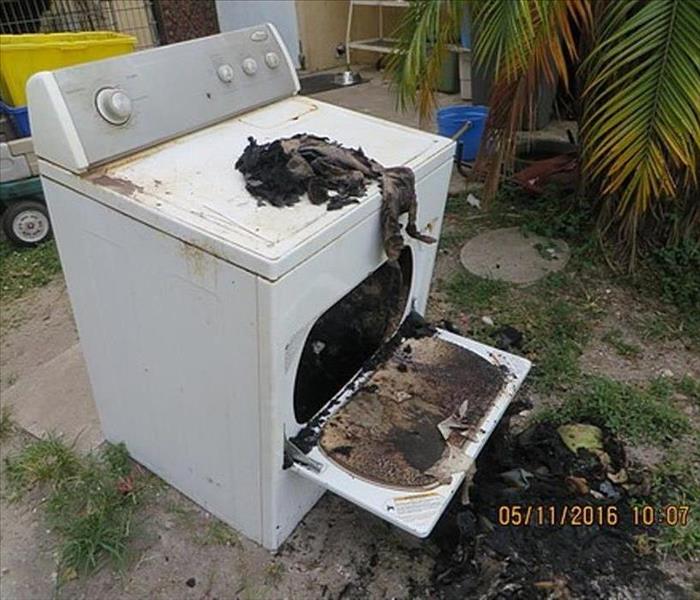 If you or a loved one has suffered from a house fire, contact our fire damage specialists immediately for 24/7 disaster help!
If you or a loved one has suffered from a house fire, contact our fire damage specialists immediately for 24/7 disaster help!
Fires are one of the most terrifying and devastating accidents that can occur in a home. Most victims of house fires will agree that they never saw it coming and never thought a tragedy like that would happen to them. Unfortunately, fires are unpredictable and alarming no matter how they happen and preparing is something that homeowners seldom think about. According to the National Fire Protection Association, approximately 1.3 million fires required U.S. fire departments responses in 2015. On average in our nation, a home fire occurs every 86 seconds. This means that there is no such thing as being too prepared for a house fire.
More than three-quarters of civilian fire deaths are caused by home structure fires. As such, homeowners must be aware of the threat of a fire in order to hopefully prevent one from occurring. In fact, research shows that the majority of home fires are completely avoidable. Having a complete understanding of typical house fires causes can play a critical role in prevention. The most common causes of house fires are:
- Cooking/cooking equipment
- Careless smoking
- Heating equipment
- Electrical equipment
- Lighting equipment
- Intentional fires (arson)
- Candles
- Curious kids
- Poor wiring
- Lightning
- Barbecues
- Flammable liquids
- Christmas decorations and trees
- Dryers and washing machines
Smoke alarms and sprinkler systems are critical for any homeowner. Most homes in the U.S. have smoke alarms, however, about 60 percent of fire deaths come from homes without smoke alarms or with non-working smoke alarms. From more obvious dangers like cooking and smoking to less obvious dangers like flammable liquids and poor wiring, being aware of the most common causes of house fires is essential to preventing them from occurring. If you or a loved one has suffered from a house fire, contact our fire damage specialists immediately for 24/7 disaster help!
Odor Removal after Fire Damage
3/30/2017 (Permalink)
 At SERVPRO of North Palm Beach County, our team of fire damage experts are trained to identify and eliminate offensive odors in your home.
At SERVPRO of North Palm Beach County, our team of fire damage experts are trained to identify and eliminate offensive odors in your home.
House fires are incredibly scary for homeowners and even neighbors. Getting out of the house safely and quickly is of course the main priority if a fire ignites in any area of the house. While making sure that you and your loved ones are safe is the first step, dealing with the aftermath of the fire comes next. After a fire, it is important to do the following:
- Limit all movement in the house in order to prevent soot particles from becoming embedded in the carpets and upholstery
- Change the HVAC filter
- Make sure hands are kept clean to not further soil the woodwork, walls, or upholstery
- Wash all houseplants on both sides of the leaves
- Take old linens or clean towels and place them on upholstery, carpet, and rugs in traffic areas
- Use a light coating of oil or petroleum jelly to protect any chrome in the house
Following the above steps, it is important to reach out to professional fire damage removal experts in order to assess the damage within the home and make recommendations for the most efficient and effective way to clean up. Odor removal and deodorization is critical in the days following a house fire. It is important to note that attempting to deodorize your home on your own can cause major issues in the long-run. As such, hiring a team of professionals will ensure a stress-free, thorough, and complete job.
At SERVPRO of North Palm Beach County, our team of fire damage experts are trained to identify and eliminate offensive odors in your home. With IICRC technical class under their belts, the fire damage team is able to properly removal all odors to ensure they stay gone forever. Too many people attempt to do this themselves and end up just masking the smell, not eliminating it. Using special equipment, the SERVPRO fire damage squad removes the odor without a trace, even odors that have penetrated surfaces.
Have you recently suffered from fire damage in your home? Is the odor just not going away? Contact our fire damage odor removal team today and we will make it "Like it never even happened."
Steps to Prevent a House Fire
12/7/2016 (Permalink)
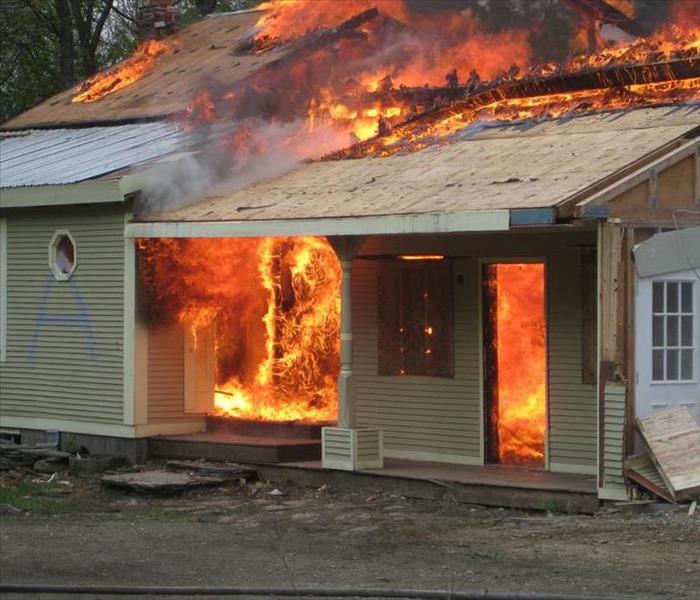 Taking the above steps to prevent home fires is incredibly important to making sure that you and your family are safe and secure in your house.
Taking the above steps to prevent home fires is incredibly important to making sure that you and your family are safe and secure in your house.
Home fires are a true danger in the United States, marking approximately 12,600 injuries and 2,500 deaths each year throughout the nation. In many cases, the smoke and heat actually poses a greater threat than the flames themselves. As such, being educated and prepared in the event of a home fire is critical. Even more important, however, is understanding how to prevent home fires from starting in the first place.
Fire spreads incredibly fast. In less than 30 seconds, a tiny flame can spread and get out of control, causing a serious fire. The most deadly fires in homes happen when the people are asleep. If a person wakes up to a fire, it is imperative that they get out of the house immediately, as there is no time to grab valuables.
From discarded cigarettes to cooking appliances, the majority of home fires are started from carelessness. Some of the most important steps to prevent house fires include:
- Never leave the kitchen while cooking. If you must leave the kitchen, turn off the stove or any other heating appliance being used.
- Barbeque grills should be placed at least 10 feet away from overhangs, branches, etc.
- Do not wear long sleeves while cooking.
- Never cook while drowsy or under the influence of drugs and/or alcohol.
- Always smoke cigarettes outside of the home.
- Ensure that cigarette butts, ashes, etc. are completely out before walking away.
- Never smoke in bed.
- Make sure all electrical and appliance wires are replaced once worn out.
- Teach children about the dangers of fire at a very young age.
- Make sure that all lighters and matches are locked in a cabinet, out of the reach of any children.
Unfortunately, far too many people underestimate the true dangers of home fires. Taking the above steps to prevent home fires is incredibly important to making sure that you and your family are safe and secure in your house. Most people who suffer in a home fire say that they never thought it would happen to them. Be sure to make a plan and take every measure to prevent a house fire.
What to do After a Fire in your Home or Commercial Building
8/24/2016 (Permalink)
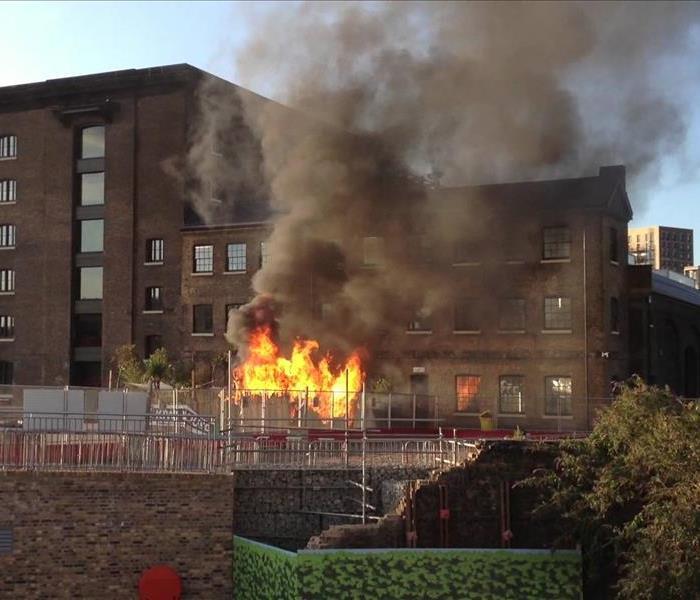 SERVPRO of North Palm Beach County specializes in fire and water damage restoration. We have the specific damage restoration training, personnel, and
SERVPRO of North Palm Beach County specializes in fire and water damage restoration. We have the specific damage restoration training, personnel, and
The days following a fire are extremely scary for a homeowner or a property manager of a commercial building. From structural damage to cleaning up and removing smoke odor, tackling a “to do” list following a fire can be daunting and overwhelming. It is important to remember that one should not enter their home or commercial property after a fire until the fire department has confirmed that it is safe to do so. According to the American Red Cross, the following actions should be taken:
- Check for structural damage
- Check utilities like telephones, electrical systems, and climate control systems
- Look around for household items that may contain toxic fumes and any other hazards (things like cleaning products may present a hazard when mixed with fumes)
- Contact a local service like SERVPRO of North Palm Beach County to clean up and remove the smoke odor
Consulting a professional is imperative to keeping the property safe and secure. When in doubt, call SERVPRO to make sure that they can clean the damage and remove the odor throughout the property.
Fire Repair and Restoration
Recovering your home and commercial building after a fire means taking the necessary steps to revive the structure. After the fire trucks leave, your home likely suffers from fire and smoke damage and extensive water damage from firefighting efforts. SERVPRO of North Palm Beach County have the specialized fire restoration training needed to restore your home to pre-fire condition.
Have Questions About Fire, Smoke, or Soot Damage? Call Today – (561) 881-8784
Every fire damage event is a little different, and requires a unique solution, but the general process stays the same. The steps listed below illustrate our process for the “typical” fire damage emergency.
Step 1: Emergency Contact
The restoration process begins when you call us. Our representative will ask questions regarding the fire damage event that will help us respond immediately with the appropriate equipment and resources.
Step 2: Inspection and Fire Damage Assessment
We carefully inspect and test adjoining rooms of your property to determine the extent of the fire, smoke, and soot damage. This step is crucial to developing a plan of action.
Step 3: Immediate Board-Up and Roof-Tarp Service
Fire damage can often compromise windows, walls, and roofs. To maintain security and to protect against further damage, we can board up missing windows and walls and place tarps on damaged roofs.
Step 4: Water Removal and Drying (if water damage is present)
The water removal process begins almost immediately and removes the majority of the water. We then use dehumidifiers and air movers to remove the remaining water and complete the drying process.
Step 5: Removal of Smoke and Soot from All Surfaces
We use specialized equipment and techniques to remove smoke and soot from ceilings, walls, and other surfaces.
Step 6: Cleaning and Sanitizing
We clean, sanitize, and disinfect all of the restorable items and structures that were damaged by the fire. We use a variety of cleaning techniques to restore your belongings to pre-fire condition. We’re also trained to remove odors using industrial air scrubbers and fogging equipment.
Step 7: Restoration
Restoration is the final step—getting your home or business to its pre-fire condition. Restoration may involve minor repairs, such as replacing drywall, painting, and installing new carpet; or it may entail major repairs such as the reconstruction of various areas or rooms in a home or business.
Remember, these steps should be carried out by trained professionals. Attempting to do these things on your own can result in unsafe conditions for you, your family, and your employees.
North Palm Beach County Smoke and Soot Cleanup
6/21/2016 (Permalink)
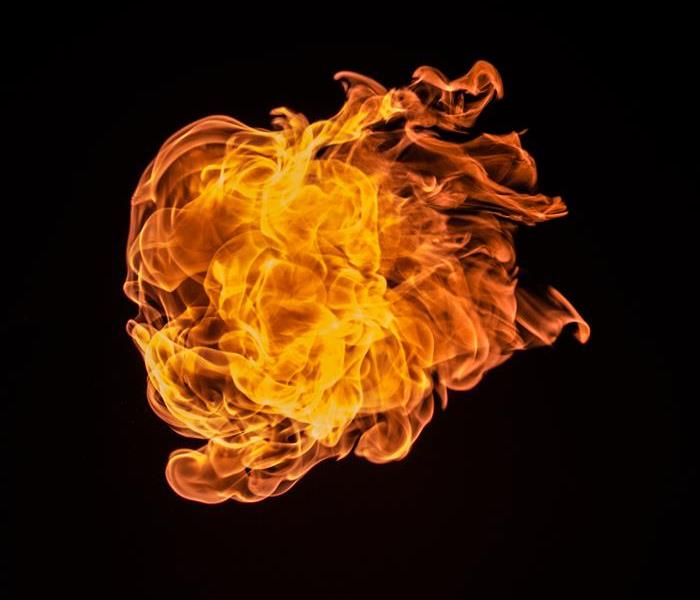 Smoke and Soot Damage Can Cause a Pervasive Odor in Your North Palm Beach County Home.
Smoke and Soot Damage Can Cause a Pervasive Odor in Your North Palm Beach County Home.
Smoke and soot is very invasive and can penetrate various cavities within your home, causing hidden damage and odor. Our smoke damage expertise and experience allows us to inspect and accurately assess the extent of the damage to develop a comprehensive plan of action.
Smoke and soot facts:
- Hot smoke migrates to cooler areas and upper levels of a structure.
- Smoke flows around plumbing systems, seeping through the holes used by pipes to go from floor to floor.
- The type of smoke may greatly affect the restoration process.
Different Types of Smoke
There are two different types of smoke–wet and dry. As a result, there are different types of soot residue after a fire. Before restoration begins, SERVPRO of North Palm Beach County will test the soot to determine which type of smoke damage occurred. The cleaning procedures will then be based on the information identified during pretesting. Here is some additional information:
Wet Smoke – Plastic and Rubber
- Low heat, smoldering, pungent odor, sticky, smeary. Smoke webs are more difficult to clean.
Dry Smoke – Paper and Wood
- Fast burning, high temperatures, heat rises therefore smoke rises.
Protein Fire Residue – Produced by evaporation of material rather than from a fire
- Virtually invisible, discolors paints and varnishes, extreme pungent odor.
Our Fire Damage Restoration Services
Since each smoke and fire damage situation is a little different, each one requires a unique solution tailored for the specific conditions. We have the equipment, expertise, and experience to restore your fire and smoke damage. We will also treat your family with empathy and respect and your property with care.
Have Questions about Fire, Smoke, or Soot Damage?
Call Us Today – 561-881-8784

 24/7 Emergency Service
24/7 Emergency Service







































